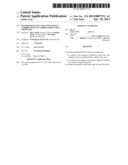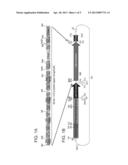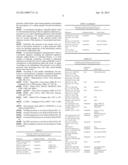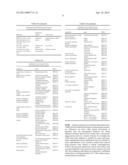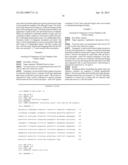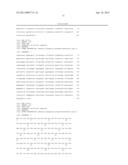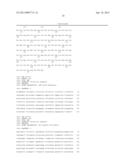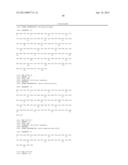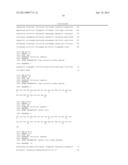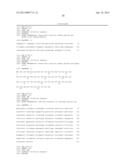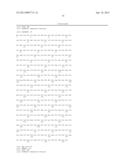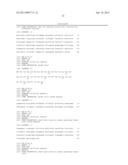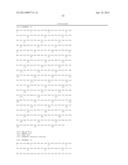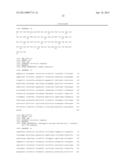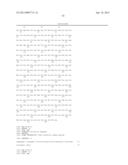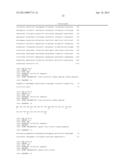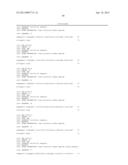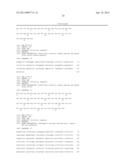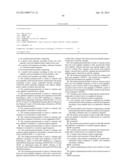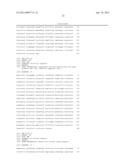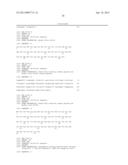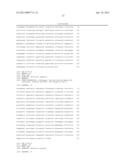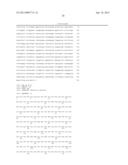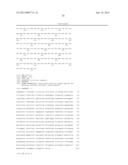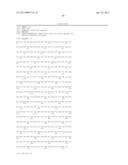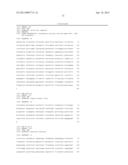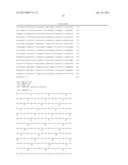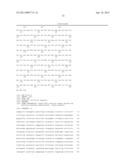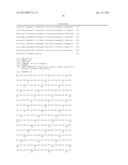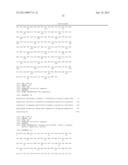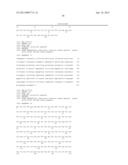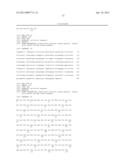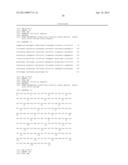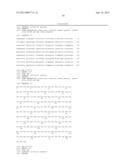Patent application title: PEST-RESISTANT PLANTS CONTAINING A COMBINATION OF A SPIDER TOXIN AND A CHITINASE
Inventors:
Dror Avisar (Kochav Yair, IL)
Hanan Stein (Nes-Ziona, IL)
Ziv Shani (Mazkeret Batia, IL)
Ziv Shani (Mazkeret Batia, IL)
Assignees:
Futuragene Israel Ltd.
IPC8 Class: AC12N1582FI
USPC Class:
800279
Class name: Multicellular living organisms and unmodified parts thereof and related processes method of introducing a polynucleotide molecule into or rearrangement of genetic material within a plant or plant part the polynucleotide confers pathogen or pest resistance
Publication date: 2013-04-18
Patent application number: 20130097731
Abstract:
An isolated polynucleotide is disclosed comprising: (i) a nucleic acid
sequence encoding at least one toxic peptide, the toxic peptide being a
spider toxin; and (ii) a nucleic acid sequence encoding a chitinase
attached to a secretion signal sequence.
Uses thereof and plants expressing same are also disclosed.Claims:
1. An isolated polynucleotide comprising: (i) a nucleic acid sequence
encoding at least one toxic peptide, said toxic peptide being a spider
toxin; and (ii) a nucleic acid sequence encoding a chitinase attached to
a secretion signal sequence.
2. An isolated polynucleotide comprising: (i) a nucleic acid sequence encoding at least one toxic peptide, said toxic peptide not being chitinase; and (ii) a nucleic acid sequence encoding a chitinase.
3. The isolated polynucleotide of claim 2, wherein said toxic peptide is derived from insects selected from the group consisting of bees, wasps, cockroach, blowfly, mosquito, webworm, beetle, antipode, millipede, crab, lobster, shrimp, prawn, spider, scorpion, mite and tick.
4. The isolated polynucleotide of claim 2, wherein said toxic peptide is derived from a spider.
5. The isolated polynucleotide of claims 1, wherein said toxic peptide comprises an amino acid sequence at least 90% homologous, and/or at least 80% identical to a sequence selected from the group consisting of SEQ ID NOs: 9, 15, 24, 30, 55, 56 and 57 as determined using the BlastP software of the National Center of Biotechnology Information (NCBI) using default parameters.
6. The isolated polynucleotide of claim 1, wherein said toxic peptide is attached to a plant lectin.
7. The isolated polynucleotide of claim 1, wherein said chitinase is not attached to a plant lectin.
8. The isolated polynucleotide of claim 6, wherein said plant lectin comprises Galanthus nivalis agglutinin (GNA).
9. The isolated polynucleotide of claim 1, wherein said toxic peptide is attached to a secretion signal sequence.
10. The isolated polynucleotide of claim 2, wherein said chitinase is attached to a secretion signal sequence.
11. The isolated polynucleotide of claim 1, wherein said secretion signal sequence is encoded by a nucleic acid as set forth in SEQ ID NOs: 7, 21 and 61-68.
12. The isolated polynucleotide of claim 1, wherein said chitinase comprises an amino acid sequence at least 90% homologous, and/or at least 80% identical to a sequence selected from the group consisting of SEQ ID NO: 36, 42 and 58-60, as determined using the BlastP software of the National Center of Biotechnology Information (NCBI) using default parameters.
13. The isolated polynucleotide of claim 1, wherein said at least one toxic peptide comprises a first and a second toxic peptide, wherein said first toxic peptide targets a first site in a sodium (Nav) channel and said second toxic peptide targets a second site in said Nav channel.
14. The isolated polynucleotide of claim 1, wherein said at least one toxic peptide comprises a first, second and a third toxic peptide, wherein said first toxic peptide targets a first site in a sodium (Nav) channel, said second toxic peptide targets a second site in said Nav channel and said third toxic peptide targets a third site in said Nav channel.
15. The isolated polynucleotide of claim 14, wherein said first toxic peptide is P83591, said second toxic peptide is P83558 and said third toxic peptide is P11060.
16. The isolated polynucleotide of claim 1, wherein said at least one toxic peptide comprises at least 4 toxic peptides, wherein a first of said at least 4 toxic peptides is P83591, a second of said at least 4 toxic peptides is P83558, a third of said at least 4 toxic peptides is P11060, a fourth of said at least 4 toxic peptides is P61095.
17. A nucleic acid construct comprising the isolated polynucleotide of claim 1 and a cis regulatory element.
18. A nucleic acid construct system comprising: (i) a first nucleic acid construct comprising an isolated polynucleotide which comprises a nucleic acid sequence encoding a toxic peptide and a cis regulatory element; and (ii) a second nucleic acid construct comprising an isolated polynucleotide which comprises a nucleic acid sequence encoding a chitinase and a cis regulatory element.
19. The nucleic acid construct system of claim 18, wherein said toxic peptide is attached to a plant lectin or a secretion signal sequence.
20. (canceled)
21. The nucleic acid construct system of claim 18, wherein said chitinase is attached to a secretion signal sequence.
22-25. (canceled)
26. A nucleic acid construct comprising the isolated polynucleotide of claim 5 and a cis regulatory element.
27. A nucleic acid construct system comprising: (i) the nucleic acid construct of claim 26; and (ii) a nucleic acid construct comprising an isolated polynucleotide which comprises a nucleic acid sequence encoding a chitinase.
28-31. (canceled)
32. A plant comprising the nucleic acid construct of claim 17.
33. A plant comprising the nucleic acid construct system of claim 18.
34-35. (canceled)
36. An insecticidal composition comprising: (i) a toxic peptide; and (ii) a chitinase.
37. (canceled)
38. A method of controlling or exterminating an insect, the method comprising expressing in a host plant of said insect the isolated polynucleotides of claim 1, thereby controlling or exterminating the insect.
39. A method of controlling or exterminating an insect, the method comprising expressing in a host plant of said insect an isolated polynucleotide which comprises a nucleic acid sequence encoding a toxic peptide selected from the group consisting of SEQ ID NOs: 9, 15, 24, 30 and 55-57.
40. A method of controlling or exterminating an insect, the method comprising contacting the insect with the insecticidal compositions of claim 36, thereby controlling or exterminating the insect.
41-45. (canceled)
Description:
FIELD AND BACKGROUND OF THE INVENTION
[0001] The present invention, in some embodiments thereof, relates to pest-resistant plants and methods of generating same.
[0002] Pests are responsible for massive yield lost by foraging on plant tissues and by transmitting microbe and viral diseases. Insecticidal agents and compositions have been developed to control insect pests such as agrohorticultural pests, hygienic pests, or wood-eating pests and in practice have been used as a single or a mixed agent.
[0003] However, it is believed that about one billion dollars are lost annually in the field due to pest attack, even with chemical control. Since the introduction of DDT in the 1940s, insect pests have been controlled almost exclusively by a limited number of broad-spectrum chemical insecticides that have led to the development of resistant populations in several important pest groups. The abusive and indiscriminate use of chemical insecticides is responsible for environmental and ecological damage to natural enemies and the death of millions of birds and fishes along with the insect-pests. In addition, there is strong epidemiological and experimental evidence linking the occurrence of cancer, Parkinson's disease and others neurological disorders to pesticide exposure. Thus, it is important at this juncture to identify and characterize novel compounds with insecticidal activity.
[0004] Spider venom contains a vast array of biologically active substances, some of which are toxins. They are thought to be a rich source of insecticidal compounds since the primary action of spider venom is to kill or paralyze arthropod prey by targeting the nervous system of these organisms. The specificity of some spider toxins acting only in insects has an enormous potential for application as bioinsecticides. The x-ACTX-Hv1a toxin (Hvt) found in the venom of the Australian funnel web spider (Hadronyche versuta) is an insect-specific calcium-channel antagonist (Norton R S, Toxicon, 1998, 36, 1573-83). The peptide is toxic to a range of agriculturally important arthropods in the Coleoptera, Lepidoptera and Diptera orders and has been reported to have no effects on a number of mammals (Norton R S, Toxicon, 1998, 36, 1573-83). Recently, active recombinant spider toxins have been cloned and expressed in prokaryotic (Fitches E. et al., Insect. Biochem. Mol. Biol., 2002, 32, 1653-61, Khan et al., Transgenic Res., 2006, 15, 349-57) and eukaryotic systems (Fitches E. et al., Insect. Biochem. Mol. Biol., 2002, 32, 1653-61), and transgenic plants expressing spider insecticidal peptides are resistant to insect attack (Khan et al., Transgenic Res., 2006, 15, 349-57).
[0005] The use of transgenic plants to control pests reduces or eliminates the need to use externally applied chemical pesticides which is often not practical or economically feasible for certain species such as large forestry tree species. Furthermore, the use of transgenic plants can effectively target pests that are otherwise not readily accessible to externally applied pesticides. For example, certain pests reside in protective galls and/or penetrate into the plant tissues via tunneling or other elusive mechanisms which partially or fully shield the pest from the externally applied toxins. Insect resistant-transgenic crops, including rice, expressing Bacillus thuringiensis (Bt) Cry toxins have been successfully and widely used for more than a decade. These toxins are highly active against coleopteran, dipteran and lepidopteron insect but lack any effective activity against hymenoptera pests (wasps and ants).
[0006] Spider venom consists of a complex mixture of substances containing a variety of toxic components. Polypeptides with insecticidal activity isolated from the venom glands of different spider species display spatial structure homology and interact with ion channels of the excitable membrane, affecting its functioning.
[0007] The transgenic expression of ω-ACTX-Hv1a toxin (Hvt) in tobacco effectively protected the plants from Helicoverpa armigera and Spodoptera littoralis larvae, with 100% mortality within 48 hours (Khan S. A. et al., Transgenic Res., 2006, 15, 349-57).
[0008] The usage of arthropod neurotoxins in transgenic plants to control tissue-chewing pests has until presently not been very successful.
[0009] Insects are protected by a hardened outer skeletal surface made of chitin. Chitin, together with additional proteins is also found in the peritrophic membrane (PM), a film-like structure that separates food from midgut tissue. It protects the epithelium against food abrasion and microrganisms and has other functions based on compartmentalization of enzymes. Chitinases are enzymes that degrade chitin but by themselves are not capable of controlling tissue chewing pests (Shakhbazau, (BLR), Rus. J. Genet. 2008, 44: 1013-22). Developmental effects on insects that were fed chitinase-transgenic plants were mild to severe, depending on the stiffness of the digested tissue that physically harmed the gut, but the plants were not totally resistant to pests.
[0010] U.S. Pat. No. 7,196,057 teaches plants expressing fusion proteins comprising a translocating moiety such as lectin and a moiety which is toxic to insects, including chitinase.
[0011] U.S. Patent Application No. 20020197689 teaches insecticidal peptides including peptides derived from Pireneitega luctuosa.
[0012] U.S. Pat. No. 5,177,308 teaches plants expressing insecticidal peptides including peptides derived from Agelenopsis aperta.
[0013] WO9949035A2 teaches plants expressing insecticidal peptides including peptides derived from Segestria florentina.
SUMMARY OF THE INVENTION
[0014] According to an aspect of some embodiments of the present invention there is provided an isolated polynucleotide comprising:
[0015] (i) a nucleic acid sequence encoding at least one toxic peptide, the toxic peptide being a spider toxin; and
[0016] (ii) a nucleic acid sequence encoding a chitinase attached to a secretion signal sequence.
[0017] According to an aspect of some embodiments of the present invention there is provided an isolated polynucleotide comprising:
[0018] (i) a nucleic acid sequence encoding at least one toxic peptide, the toxic peptide not being chitinase; and
[0019] (ii) a nucleic acid sequence encoding a chitinase.
[0020] According to an aspect of some embodiments of the present invention there is provided a nucleic acid construct comprising an isolated polynucleotide of the present invention and a cis regulatory element.
[0021] According to an aspect of some embodiments of the present invention there is provided a nucleic acid construct system comprising:
[0022] (i) a first nucleic acid construct comprising an isolated polynucleotide which comprises a nucleic acid sequence encoding a toxic peptide and a cis regulatory element; and
[0023] (ii) a second nucleic acid construct comprising an isolated polynucleotide which comprises a nucleic acid sequence encoding a chitinase and a cis regulatory element.
[0024] According to an aspect of some embodiments of the present invention there is provided an isolated polypeptide comprising a toxic peptide which comprises a sequence at least 90% homologous, and/or at least 80% identical to a sequence selected from the group consisting of SEQ ID NOs: 9, 15, 24, 30, 55 and 56-60 as determined using the BlastP software of the National Center of Biotechnology Information (NCBI) using default parameters, the toxic peptide being attached to a plant lectin.
[0025] According to an aspect of some embodiments of the present invention there is provided an insecticidal composition comprising:
[0026] (i) a toxic peptide; and
[0027] (ii) a chitinase
[0028] According to an aspect of some embodiments of the present invention there is provided a method of controlling or exterminating an insect, the method comprising expressing in a host plant of the insect any of the isolated polynucleotides of the present invention, thereby controlling or exterminating the insect.
[0029] According to an aspect of some embodiments of the present invention there is provided a method of controlling or exterminating an insect, the method comprising expressing in a host plant of the insect an isolated polynucleotide which comprises a nucleic acid sequence encoding a toxic peptide selected from the group consisting of SEQ ID NOs: 9, 15, 24, 30 and 55-57.
[0030] According to an aspect of some embodiments of the present invention there is provided a method of controlling or exterminating an insect, the method comprising contacting the insect with any of the insecticidal compositions of the present invention, thereby controlling or exterminating the insect.
[0031] According to some embodiments of the invention, the toxic peptide is derived from insects selected from the group consisting of bees, wasps, cockroach, blowfly, mosquito, webworm, beetle, antipode, millipede, crab, lobster, shrimp, prawn, spider, scorpion, mite and tick.
[0032] According to some embodiments of the invention, the toxic peptide is derived from a spider.
[0033] According to some embodiments of the invention, the toxic peptide comprises an amino acid sequence at least 90% homologous, and/or at least 80% identical to a sequence selected from the group consisting of SEQ ID NOs: 9, 15, 24, 30, 55, 56 and 57 as determined using the BlastP software of the National Center of Biotechnology Information (NCBI) using default parameters.
[0034] According to some embodiments of the invention, the toxic peptide is attached to a plant lectin.
[0035] According to some embodiments of the invention, the chitinase is not attached to a plant lectin.
[0036] According to some embodiments of the invention, the plant lectin comprises Galanthus nivalis agglutinin (GNA).
[0037] According to some embodiments of the invention, the toxic peptide is attached to a secretion signal sequence.
[0038] According to some embodiments of the invention, the chitinase is attached to a secretion signal sequence.
[0039] According to some embodiments of the invention, the secretion signal sequence is encoded by a nucleic acid as set forth in SEQ ID NOs: 7, 21 and 61-68.
[0040] According to some embodiments of the invention, the chitinase comprises an amino acid sequence at least 90% homologous, and/or at least 80% identical to a sequence selected from the group consisting of SEQ ID NO: 36, 42 and 58-60, as determined using the BlastP software of the National Center of Biotechnology Information (NCBI) using default parameters.
[0041] According to some embodiments of the invention, the at least one toxic peptide comprises a first and a second toxic peptide, wherein the first toxic peptide targets a first site in a sodium (Nav) channel and the second toxic peptide targets a second site in the Nav channel.
[0042] According to some embodiments of the invention, the at least one toxic peptide comprises a first, second and a third toxic peptide, wherein the first toxic peptide targets a first site in a sodium (Nav) channel, the second toxic peptide targets a second site in the Nav channel and the third toxic peptide targets a third site in the Nav channel.
[0043] According to some embodiments of the invention, the first toxic peptide is P83591, the second toxic peptide is P83558 and the third toxic peptide is P11060.
[0044] According to some embodiments of the invention, the at least one toxic peptide comprises at least 4 toxic peptides, wherein a first of the at least 4 toxic peptides is P83591, a second of the at least 4 toxic peptides is P83558, a third of the at least 4 toxic peptides is P11060, a first of the at least 4 toxic peptides is P61095.
[0045] According to some embodiments of the invention, the toxic peptide is attached to a plant lectin.
[0046] According to some embodiments of the invention, the toxic peptide is attached to a secretion signal sequence.
[0047] According to some embodiments of the invention, the chitinase is attached to a secretion signal sequence.
[0048] According to some embodiments of the invention, the isolated polypeptide further comprises a secretion signal peptide.
[0049] According to some embodiments of the invention, the isolated polynucleotide comprises a nucleic acid sequence encoding an isolated polypeptide of the invention.
[0050] According to some embodiments of the invention, the isolated polynucleotide further comprises a nucleic acid sequence encoding a chitinase.
[0051] According to some embodiments of the invention, the nucleic acid construct comprises the isolated polynucleotide of the present invention and a cis regulatory element.
[0052] According to some embodiments of the invention, the nucleic acid construct system comprises:
[0053] (i) a nucleic acid construct of the present invention; and
[0054] (ii) a nucleic acid construct comprising an isolated polynucleotide which comprises a nucleic acid sequence encoding a chitinase.
[0055] According to some embodiments of the invention, the cis-regulatory element is a promoter.
[0056] According to some embodiments of the invention, the promoter is SVBV or sgFiMV.
[0057] According to some embodiments of the invention, the promoter is a plant promoter.
[0058] According to some embodiments of the invention, the plant promoter is a leaf-specific promoter.
[0059] According to some embodiments of the invention, the plant comprises the nucleic acid construct of the present invention.
[0060] According to some embodiments of the invention, the plant comprises the nucleic acid construct system of the present invention.
[0061] According to some embodiments of the invention, the plant is a tree.
[0062] According to some embodiments of the invention, the plant is a eucalyptus tree.
[0063] According to some embodiments of the invention, the insecticidal composition comprises the isolated polypeptide of the present invention.
[0064] According to some embodiments of the invention, the insect comprises a sessile gall nesting insect.
[0065] According to some embodiments of the invention, the sessile gall nesting insect comprises a gall wasp.
[0066] According to some embodiments of the invention, the expressing is effected using a nucleic acid construct comprising a leaf-specific promoter.
[0067] According to some embodiments of the invention, the host plant comprises a tree.
[0068] According to some embodiments of the invention, the tree is a eucalyptus tree.
[0069] Unless otherwise defined, all technical and/or scientific terms used herein have the same meaning as commonly understood by one of ordinary skill in the art to which the invention pertains. Although methods and materials similar or equivalent to those described herein can be used in the practice or testing of embodiments of the invention, exemplary methods and/or materials are described below. In case of conflict, the patent specification, including definitions, will control. In addition, the materials, methods, and examples are illustrative only and are not intended to be necessarily limiting.
BRIEF DESCRIPTION OF THE DRAWINGS
[0070] Some embodiments of the invention are herein described, by way of example only, with reference to the accompanying drawings. With specific reference now to the drawings in detail, it is stressed that the particulars shown are by way of example and for purposes of illustrative discussion of embodiments of the invention. In this regard, the description taken with the drawings makes apparent to those skilled in the art how embodiments of the invention may be practiced.
[0071] In the drawings:
[0072] FIGS. 1A-B are schemes illustrating the construction of an expression vector according to one embodiment of the present invention (vector #257). FIG. 1A illustrates the synthetic fragment and FIG. 1B illustrates the vector in which it is inserted.
[0073] FIG. 2 is a photograph of a restriction analysis confirming the insertion and correct orientation of insert AntiInsects6Cassete into the vector.
[0074] FIGS. 3A-C are schemes illustrating the construction of an expression vector according to one embodiment of the present invention (vector #258). FIGS. 3A and 3B illustrates the synthetic fragments and FIG. 3C illustrates the vector in which it is inserted.
[0075] FIG. 4 is a photograph of a restriction analysis confirming the insertion of insert AntiInsects6CDS GNA into the vector.
[0076] FIG. 5 is a scheme illustrating two exemplary constructs of the present invention, with annotated sequences.
DESCRIPTION OF SPECIFIC EMBODIMENTS OF THE INVENTION
[0077] The present invention, in some embodiments thereof, relates to pest-resistant plants and methods of generating same.
[0078] Before explaining at least one embodiment of the invention in detail, it is to be understood that the invention is not necessarily limited in its application to the details set forth in the following description or exemplified by the Examples. The invention is capable of other embodiments or of being practiced or carried out in various ways. Insect-pests are global problems that cause severe damage to crop plants, and their control is commonly based on chemical insecticides. However, negative effects of pesticides on the environment and human health emphasize the necessity to develop alternative methods for insect-pest control.
[0079] Pests are responsible for massive yield lost by foraging on plant tissues and by transmitting microbe and viral diseases.
[0080] The use of transgenic plants to control pests reduces or eliminates the need to use externally applied chemical pesticides which is often not practical or economically feasible for certain species such as large forestry tree species. Furthermore, the use of transgenic plants can effectively target pests that are otherwise not readily accessible to externally applied pesticides. For example, certain pests reside in protective galls and/or penetrate into the plant tissues via tunneling or other elusive mechanisms which partially or fully shield the pest from the externally applied toxins.
[0081] One particular toxin which has been expressed in plants for the purpose of controlling pests is chitinase. This toxin acts by both dissolving both the outer cuticle of the insect pest and its peritrophic membrane (PM), the film-like structure that separates food from midgut tissue.
[0082] However, soft tissue and sap feeding insects are not likely to be affected by the disruption of the PM. Accordingly, the present inventors propose the co-expression of chitinases and spider neurotoxins in plants to control herbivorous pests. The chitinases would interfere with the intact chitin, improving the chance of the spider toxin to penetrate the hemolymph.
[0083] The present inventors further propose fusion of the spider neurotoxin to a plant secretion leader peptide. This would allow the toxin to be translated in the ER pathway and to be secreted to the extracellular matrix. In this way, sap feeding and gall nesting pests which may be protected from inner cellular agents might be exposed to the spider neurotoxins not only by digestion of plant material but also by its outer surface. Thus, gall nesting pests developing inside the galls would be exposed to the toxin for a long time through both digestion and cuticle absorption.
[0084] Thus, according to a first aspect of the invention there is provided a method of controlling or exterminating an insect, the method comprising expressing in a host plant of the insect a chitinase and at least one toxic peptide, thereby controlling or exterminating the insect.
[0085] Contemplated insects for control or extermination include those that affect the growth, development, reproduction, harvest, yield or utility of a plant.
[0086] According to one embodiment the insects to be eradicated are sessile insects. According to another embodiment, the insects are gall nesting insects, such as for example sessile gall wasps (Cynipidae). Particular contemplated species of sessile gall wasps include, but are not limited to Leptocybe invasa, Ophelimus maskelli and Selitrichodes globulus. Other insects for control or extermination include, but are not limited to Coleopterans eg. Southern corn rootworm (Diabrotica undecimpunctata); cowpea bruchid (Callosobruchus maculatus); Lepidopterans eg. European cornborer (Ostinia nubilalis); tobacco hornworm (Manduca sexta); stem borer (Chilo partellus):
[0087] Homopteran pests eg. Rice brown plant hopper (Nilaparvata lugens); rice green leaf hopper (Nephotettix cinciteps); potato leaf hopper (Empoasca fabae); peach potato aphid (Myzus persicae).
[0088] The term "plant" as used herein encompasses whole plants, ancestors and progeny of the plants and plant parts, including seeds, shoots, stems, roots (including tubers), and plant cells, tissues and organs. The plant may be in any form including suspension cultures, embryos, meristematic regions, callus tissue, leaves, gametophytes, sporophytes, pollen, and microspores. Plants that are particularly useful in the methods of the invention include all plants which belong to the superfamily Viridiplantee, in particular monocotyledonous and dicotyledonous plants including a fodder or forage legume, ornamental plant, food crop, tree, or shrub selected from the list comprising Acacia spp., Acer spp., Actinidia spp., Aesculus spp., Agathis australis, Albizia amara, Alsophila tricolor, Andropogon spp., Arachis spp, Areca catechu, Astelia fragrans, Astragalus cicer, Baikiaea plurijuga, Betula spp., Brassica spp., Bruguiera gymnorrhiza, Burkea africana, Butea frondosa, Cadaba farinosa, Calliandra spp, Camellia sinensis, Canna indica, Capsicum spp., Cassia spp., Centroema pubescens, Chacoomeles spp., Cinnamomum cassia, Coffea arabica, Colophospermum mopane, Coronillia varia, Cotoneaster serotina, Crataegus spp., Cucumis spp., Cupressus spp., Cyathea dealbata, Cydonia oblonga, Cryptomeria japonica, Cymbopogon spp., Cynthea dealbata, Cydonia oblonga, Dalbergia monetaria, Davallia divaricata, Desmodium spp., Dicksonia squarosa, Dibeteropogon amplectens, Dioclea spp, Dolichos spp., Dorycnium rectum, Echinochloa pyramidalis, Ehraffia spp., Eleusine coracana, Eragrestis spp., Erythrina spp., Eucalyptus spp., Euclea schimperi, Eulalia vi/losa, Pagopyrum spp., Feijoa sellowlana, Fragaria spp., Flemingia spp, Freycinetia banksli, Geranium thunbergii, GinAgo biloba, Glycine javanica, Gliricidia spp, Gossypium hirsutum, Grevillea spp., Guibourtia coleosperma, Hedysarum spp., Hemaffhia altissima, Heteropogon contoffus, Hordeum vulgare, Hyparrhenia rufa, Hypericum erectum, Hypeffhelia dissolute, Indigo incamata, Iris spp., Leptarrhena pyrolifolia, Lespediza spp., Lettuca spp., Leucaena leucocephala, Loudetia simplex, Lotonus bainesli, Lotus spp., Macrotyloma axillare, Malus spp., Manihot esculenta, Medicago saliva, Metasequoia glyptostroboides, Musa sapientum, Nicotianum spp., Onobrychis spp., Ornithopus spp., Oryza spp., Peltophorum africanum, Pennisetum spp., Persea gratissima, Petunia spp., Phaseolus spp., Phoenix canariensis, Phormium cookianum, Photinia spp., Picea glauca, Pinus spp., Pisum sativam, Podocarpus totara, Pogonarthria fleckii, Pogonaffhria squarrosa, Populus spp., Prosopis cineraria, Pseudotsuga menziesii, Pterolobium stellatum, Pyrus communis, Quercus spp., Rhaphiolepsis umbellata, Rhopalostylis sapida, Rhus natalensis, Ribes grossularia, Ribes spp., Robinia pseudoacacia, Rosa spp., Rubus spp., Salix spp., Schyzachyrium sanguineum, Sciadopitys vefficillata, Sequoia sempervirens, Sequoiadendron giganteum, Sorghum bicolor, Spinacia spp., Sporobolus fimbriatus, Stiburus alopecuroides, Stylosanthos humilis, Tadehagi spp, Taxodium distichum, Themeda triandra, Trifolium spp., Triticum spp., Tsuga heterophylla, Vaccinium spp., Vicia spp., Vitis vinifera, Watsonia pyramidata, Zantedeschia aethiopica, Zea mays, amaranth, artichoke, asparagus, broccoli, Brussels sprouts, cabbage, canola, carrot, cauliflower, celery, collard greens, flax, kale, lentil, oilseed rape, okra, onion, potato, rice, soybean, straw, sugar beet, sugar cane, sunflower, tomato, squash tea, trees. Alternatively algae and other non-Viridiplantae can be used for the methods of the present invention. According to a specific embodiment, the tree is a eucalyptus tree.
[0089] As mentioned, the method of the present invention is affected by co-expressing at least one toxic peptide and at least one chitinase in the plant.
[0090] In order to express the toxic peptides and chitinases in plants, polynucleotides encoding same are inserted into expression constructs and introduced into the plants (plant transformation) such that expression occurs in the plant, as further described herein below.
[0091] The present invention contemplates expressing one, two, three, four or more toxic peptides. Toxic peptides include any peptide (including its metabolic precursor or pro-agent), that affects the wellbeing, growth or reproduction of an insect and/or any stages of its life cycle. According to one embodiment, the toxic peptide is derived from insects or related arthropods.
[0092] In a preferred embodiment of the invention the toxic peptide that is expressed in the plant is in its mature form and, ideally, is a natural or synthetic arthropod-derived peptide or protein or metabolite or analogue thereof, capable of causing deleterious effects on growth, development reproduction or mortality in pest insects; such as an insect or related arthropod or the like derived protein or peptide or neuropeptide or metabolite or analogue thereof.
[0093] Suitably the toxic peptide is derived from insects such as cockroach, blowfly, mosquito, webworm, beetle, wasps, bees, or related arthropods such as antipode, millipede, crab, lobster, shrimp, prawn, spider, scorpion, mite, tick and the like.
[0094] Exemplary insect toxins that may be used to carry out the present invention are described in U.S. Pat. No. 6,162,430 and U.S. Pat. No. 7,196,057, the contents of both being incorporated herein by reference.
[0095] According to one embodiment, the toxic peptide is selectively toxic towards a particular insect. Such toxins are further described by Nicholson (Toxicon 49 (2007) 490-512), the contents of which are incorporated herein by reference.
[0096] According to another embodiment, the toxic peptide is selectively toxic towards non-vertebrates.
[0097] Suitable toxic insect peptides include any one or more of the following neuropeptides and their natural or synthetic metabolites or analogues: Manduca sexta allatostatin (Manse-AS); cockroach allatostatin such as those found in either of the following species Diplotera punctata or Periplaneta americana or blowfly allatostatin such as in the species Calliphora vomitaria; alternatively, peptides comprising, or derived from, insect diuretic hormones such as those isolated from any one or more of the aforementioned species, or related arthropod hormones may be used.
[0098] A useful scorpion toxin is, for example, AaIT from Androctonus australis. Zlotkin et al., Biochimie, 53, 1073-1078 (1971). An useful snail venom is that from the snail Conus querciones, which the animal delivers by mouth and some individual toxins of which appear to be selective for arthropods including insects. See, for example, Olivera et al., "Diversity of Conus Neuropeptides," Science, 249:257-263 (1990).
[0099] According to a particular embodiment, the toxic peptide is a spider toxin (e.g a spider neurotoxin).
[0100] The spider neurotoxin may act by targeting a voltage gated sodium (Nay) channel of the insect.
[0101] Exemplary insect selective spider toxin include, but are not limited to hainantoxin (which targets site 1 of the Nav channel); Tx4(6-1) and Magi 2 (which target site 3 of the the Nav channel); and δPalutoxin (which targets site 4 of the the Nav channel).
[0102] As mentioned, the present invention contemplates expressing one, two, three, four or more toxic peptides. According to a specific embodiment, each peptide which is expressed targets a different site, thus allowing synergistic effects of the toxic peptides. Thus, for example, the present invention contemplates selecting spider toxins which target different sites on the voltage gated sodium channel such as P83591 (targets site 1 of the sodium channel), P83558 (targets site 3 of the sodium channel) and P11060 (targets site 4 of the sodium channel).
[0103] An exemplary combination of spider toxin that may be expressed in the plant is P83591, P83558, P11060 and P61095.
[0104] According to a preferred embodiment, the insect peptide is derived from Haplopelma hainanum, Macrothele gigas, Phoneutria nigriventer, Pireneitega luctuosa, Agelenopsis aperta or Segestria florentina.
[0105] Contemplated peptide toxins include those having a sequence at least 90% homologous, and/or at least 80% identical to a sequence selected from the group consisting of SEQ ID NOs: 9, 15, 24, 30, 55, 56 and 57 as determined using the BlastP software of the National Center of Biotechnology Information (NCBI) using default parameters.
[0106] The choice of toxic peptide will be determined by the nature of the pathogen to be destroyed. For example, the size of a toxic agent may be chosen on the basis of the type of gut wall to be penetrated and the effectiveness of the toxic agent will be based on the type of insect to be destroyed.
[0107] According to one embodiment the toxic peptides of this aspect of the present invention are attached to a plant lectin.
[0108] According to a particular embodiment, the toxic peptide and/or the chitinase is upstream to the lectin.
[0109] Suitable plant lectins which may be attached to the toxic peptides and/or chitinases include any that are capable of penetrating into the insect gut. The choice of which type of lectin to be selected depends on its stability in the insect gut, the type of gut wall to be penetrated and its level of toxicity; a non toxic lectin is preferred.
[0110] Examples of plant lectins include, but are not limited to snowdrop lectin (GNA), pea lectin Pisum sativum (P-lec), peanut lectin Arachis hypogaea, french bean lectin (PHA, phytohaemo glutinin), Zephyranthes candida lectin, Amaryllis minuta lectin, Hippeastrum vittatum lectin, Clivia miniata lectin, Lycoris radiate lectin, Narcissus tazetta lectin and Narcissus hybrid lectin and analogues thereof.
[0111] In a preferred embodiment of the invention the plant protein is selected from the following group of proteins: GNA (snowdrop lectin; SEQ ID NO: 46); P-lec pea lectin; and peanut lectin.
[0112] Preferably the toxic peptides and lectin are linked together by genetic or biochemical means and so, in the first instance, by at least one linking peptide or, in the second instance, by a covalent or non-covalent bond or linking moiety. Where a peptide is used to link the members together the number of peptides is determined by the distance between the relevant ends of each member when the fusion protein is in a biologically active conformation. The moieties may be releasably linked by means adapted to dissociate and release the toxic agent in situ in an insect gut, for example on metabolisation by the insect or may remain intact, depending on the active form of the toxic agent.
[0113] Thus an exemplary polynucleotide of the present invention is one set forth in SEQ ID NO: 47 which encodes a Fused Plant secretion leader peptide from sp|Q56YT0|LAC3_At Laccase+Spider toxin P83591+GNA, as set forth in SEQ ID NO: 48. Another exemplary polynucleotide of the present invention is one set forth in SEQ ID NO: 49 which encodes a Fused Plant secretion leader peptide from sp|Q56YT0|LAC3_At Laccase+Spider toxin P83558+GNA, as set forth in SEQ ID NO: 50. Another exemplary polynucleotide of the present invention is one set forth in SEQ ID NO: 51 which encodes a Fused Plant secretion leader peptide from tr|Q6TDS6|Q6TDS6_GOSAR Secretory laccase Gossypium arboreum+Spider toxin P11060+GNA, as set forth in SEQ ID NO: 52. Another exemplary polynucleotide of the present invention is one set forth in SEQ ID NO: 53 which encodes a Fused Plant secretion leader peptide from sp|Q56YT0|LAC3_At Laccase+Spider toxin P61095+GNA, as set forth in SEQ ID NO: 54.
[0114] As mentioned, the method of the present invention is affected by co-expressing a chitinase and a toxic peptide in a plant.
[0115] As used herein, the term "chitinase" refers to an enzyme which digests chitin [poly(β-1,4-N-acetyl D-glucosamine)] to generate oligosaccharides and N-acetylglucosamine. In order to test whether a polypeptide comprises chitinase activity, the polypeptide may be brought into contact with a substrate of chitinase, and then the digestion and/or a degree thereof of the chitinase substrate is analyzed [for example, Johannes et al., Infect. Immun., 69, 4041-4047 (2001)]. For example, a polypeptide to be tested is added to a well of an agarose gel containing an appropriate substrate of chitinase (for example, glycol chitin or chitin), and incubated for a predetermined period (for example, at 37° C. for 12 hours). The gel is stained with an appropriate dye [for example, Fluorescent Brightener 28 (Sigma)] and observed under an ultraviolet ray. The portion in which chitin is digested by chitinase does not react with the dye, and becomes black. In this case, it may be judged that the polypeptide to be tested exhibits the chitinase activity. Conversely, when the chitinase reaction does not occur, the gel is brightened by the reaction with the dye. In this case, it may be judged that the polypeptide to be tested does not exhibit the chitinase activity.
[0116] Suitable chitinases that may be co-expressed in the plants include insect chitinase such as those for example, found in M. sexta; Bombyx mori; the mosquito Anopheles gambiae; fall webworm Hyphantria cunea; beetle Phaedon cochleariae; or Lacanobia oleracea.
[0117] According to one embodiment, the chitinase is derived from an organism which digests insect chitin as part of its diet. Thus, for example chitinases from the plant Nepenthes khasiana and the fungus Beauveria bassiana are contemplated for use in the present invention.
[0118] Chitinases have been isolated from many plant species and they are classified into 5 classes (I-V) according to their multi-domain structure (Collinge et al., 1993; Hamel et al., 1997) and the present invention contemplates the use of any of these classes.
[0119] Class I chitinases are mainly composed of basic proteins (with basic pI values), mostly targeted to the vacuoles and found in both monocots and dicots. These enzymes display high specific activities and are responsible for the majority of the plant chitinolytic activity in roots, shoots and flowers (Legrand et al., 1987). Class I chitinases are composed of five structural domains: (i) N-terminal signal peptide (20-27 amino acids residues) that routes the protein into the endoplasmic reticulum; (ii) cysteine rich domain (CRD of about 40 amino acids), which is involved in chitin binding and contains eight cysteine residues in highly conserved positions; (iii) proline (mostly hydroxyproline)-rich hinge region (HR) that varies in size; (iv) catalytic domain (CD>220 amino acids), comprising the central domain of the protein that shows high homology to the catalytic domain of class II and IV chitinases and low homology to the CD of bacterial chitinases; and (v) carboxy-terminal extension (CTE), which targets the protein into the vacuole and is present in most of class I chitinases (Graham and Sticklen, 1994; Hamel et al., 1987). Rapid release of large amounts of the vacuole-compartmentalized chitinase occurs during cell lysis resulting from hypersensitive response to pathogen invasion. Several class I-basic chitinases, which are devoid of CTE, have also been characterized. These chitinases are secreted to the extracellular space (Legrand et al., 1987; Swegle et al., 1992; Vad et al., 1991).
[0120] Class II chitinases are acidic (with acidic pI), containing only the signal peptide and catalytic domain. The latter shows a high amino acid sequence homology to the catalytic region of class I and class IV chitinases. The specific activity of acidic chitinases is lower than that of class I-chitinases. It is assumed that the primary function of class II-chitinases is to generate elicitors of defense responses by partial degradation of the fungal pathogen cell wall (Graham and Sticklen, 1994).
[0121] Class III chitinases include basic or acidic extracellular proteins with chitinase/lysozyme activity. Their catalytic domain is different from that of class I and II but shares significant identity with chitinases from yeast and filamentous fungi.
[0122] Class IV chitinases share structural domain similarity with class I chitinases but not a high amino acid sequence identity. All of class IV enzymes lack the CTE and are therefore targeted to the apoplast. In addition, amino acid sequence alignment with class I proteins showed four distinct deletions; one in the chitin binding domain and three within the catalytic domain. This group include the PR4 chitinase from bean, the ChB4 from Canola and many others (Hamel et al., 1997).
[0123] Class V chitinases share some homology to exo-chitinases of bacterial origins, e.g. Serracia marcescens, Bacillus circulans and Streptomyces plicatus.
[0124] Exemplary chitinase sequences include but are not limited to those having a sequence at least 90% homologous, and/or at least 80% identical to a sequence selected from the group consisting of SEQ ID NOs: 36, 42 and 58-60 as determined using the BlastP software of the National Center of Biotechnology Information (NCBI) using default parameters.
[0125] The present invention contemplates attaching either the toxic peptide, the chitinase or both to a signal peptide. According to one embodiment, the signal peptide is a secretion signal peptide such that they are excreted into the extracellular matrix.
[0126] As used herein, the phrase "signal peptide" refers to a peptide linked in frame to the amino terminus of a polypeptide and directs the encoded polypeptide into a cell's secretory pathway.
[0127] Thus, the present invention contemplates the polynucleotide sequence SEQ ID NO: 11 which encodes for SEQ ID NO: 12 (fused plant secretion leader peptide form sp. Q56YTO/LAC3_At Laccase and spider toxin P83591); the polynucleotide sequence SEQ ID NO: 17 which encodes for SEQ ID NO: 18 (fused plant secretion leader peptide form sp. Q56YTO/LAC3_At Laccase and spider toxin P83558); the polynucleotide sequence SEQ ID NO: 25 which encodes for SEQ ID NO: 26 (fused plant secretion leader peptide from tr|Q6TDS6|Q6TDS6_GOSAR Secretory laccase Gossypium arboreum and spider toxin P11060); the polynucleotide sequence SEQ ID NO: 31 which encodes for SEQ ID NO: 32 (fused plant secretion leader peptide form sp. Q56YTO/LAC3_At Laccase and spider toxin P61095); the polynucleotide sequence SEQ ID NO: 37 which encodes for SEQ ID NO: 38 (fused plant secretion leader peptide form sp. Q56YTO/LAC3_At Laccase and Beauveria bassiana chitinase gb/ACF32998.1; the polynucleotide sequence SEQ ID NO: 43 which encodes for SEQ ID NO: 44 (fused plant secretion leader peptide from tr|Q6TDS6|Q6_TDS6_GOSAR Secretory laccase Gossypium arboreum and Beauveria bassiana endochitinase gb/AAN41261.1.
[0128] As mentioned, in order to express the toxic peptides and chitinases in plants, polynucleotides encoding same are introduced into the plants (plant transformation) such that expression occurs in the plant.
[0129] Nucleic acid sequences according to this aspect of the present invention can be a complementary polynucleotide sequence (cDNA), a genomic polynucleotide sequence and/or a composite polynucleotide sequences (e.g., a combination of the above).
[0130] As used herein the phrase "complementary polynucleotide sequence" refers to a sequence, which results from reverse transcription of messenger RNA using a reverse transcriptase or any other RNA dependent DNA polymerase. Such a sequence can be subsequently amplified in vivo or in vitro using a DNA dependent DNA polymerase.
[0131] As used herein the phrase "genomic polynucleotide sequence" refers to a sequence derived (isolated) from a chromosome and thus it represents a contiguous portion of a chromosome.
[0132] As used herein the phrase "composite polynucleotide sequence" refers to a sequence, which is at least partially complementary and at least partially genomic. A composite sequence can include some exonal sequences required to encode the polypeptide of the present invention, as well as some intronic sequences interposing therebetween. The intronic sequences can be of any source, including of other genes, and typically will include conserved splicing signal sequences. Such intronic sequences may further include cis acting expression regulatory elements.
[0133] The nucleic acid sequences encoding the toxic peptide and chitinase according to this aspect of the present invention may be altered, to further improve expression levels in plant expression system. For example, the nucleic acid sequence of the toxic peptide and/or chitinase may be modified in accordance with the preferred codon usage for plant expression. Increased expression of the toxic peptide and/or chitinase in plants may be obtained by utilizing a modified or derivative nucleotide sequence. Examples of such sequence modifications include, but are not limited to, an altered G/C content to more closely approach that typically found in plants, and the removal of codons atypically found in plants commonly referred to as codon optimization.
[0134] The phrase "codon optimization" refers to the selection of appropriate DNA nucleotides for use within a structural gene or fragment thereof that approaches codon usage within a plant. Therefore, an optimized gene or nucleic acid sequence refers to a gene in which the nucleotide sequence of a native or naturally occurring gene has been modified in order to utilize statistically-preferred or statistically-favored codons within a plant. The nucleotide sequence typically is examined at the DNA level and the coding region optimized for expression in plants determined using any suitable procedure, for example as described in Sardana et al. (1996, Plant Cell Reports 15:677-681). In this method, the standard deviation of codon usage, a measure of codon usage bias, may be calculated by first finding the squared proportional deviation of usage of each codon of the native heparanase gene relative to that of highly expressed plant genes, followed by a calculation of the average squared deviation. The formula used is: 1 SDCU=n=1 N[(Xn-Yn)/Yn]2/N, where Xn refers to the frequency of usage of codon n in highly expressed plant genes, where Yn to the frequency of usage of codon n in the gene of interest and N refers to the total number of codons in the gene of interest. A table of codon usage from highly expressed genes of dicotyledonous plants is compiled using the data of Murray et al. (1989, Nuc Acids Res. 17:477-498).
[0135] The nucleic acid sequence encoding the toxic peptide and/or chitinase may be altered, to further improve expression levels for example, by optimizing the nucleic acid sequence in accordance with the preferred codon usage for a particular plant cell type which is selected for the expression of the toxic peptide and/or chitinase polypeptide. Use of tobacco plants for the expression of the toxic peptide and/or chitinase (as described in the Examples section hereinbelow) may limit the need for optimizing the nucleic acid sequence in accordance with the preferred codon usage since tobacco plant codon usage/preference is generally very similar to humans
[0136] One method of optimizing the nucleic acid sequence in accordance with the preferred codon usage for a particular plant cell type is based on the direct use, without performing any extra statistical calculations, of codon optimization tables such as those provided on-line at the Codon Usage Database through the NIAS (National Institute of Agrobiological Sciences) DNA bank in Japan (www.kazusa.or.jp/codon/). The Codon Usage Database contains codon usage tables for a number of different species, with each codon usage table having been statistically determined based on the data present in Genbank
[0137] By using the above tables to determine the most preferred or most favored codons for each amino acid in a particular species (for example, rice), a naturally-occurring nucleotide sequence encoding a protein of interest can be codon optimized for that particular plant species. This is effected by replacing codons that may have a low statistical incidence in the particular species genome with corresponding codons, in regard to an amino acid, that are statistically more favored. However, one or more less-favored codons may be selected to delete existing restriction sites, to create new ones at potentially useful junctions (5' and 3' ends to add signal peptide or termination cassettes, internal sites that might be used to cut and splice segments together to produce a correct full-length sequence), or to eliminate nucleotide sequences that may negatively effect mRNA stability or expression.
[0138] The naturally-occurring or native toxic peptide and/or chitinase encoding nucleotide sequence may already, in advance of any modification, contain a number of codons that correspond to a statistically-favored codon in a particular plant species. Therefore, codon optimization of the native toxic peptide and/or chitinase nucleotide sequence may comprise determining which codons, within the native the toxic peptide and/or chitinase nucleotide sequence, are not statistically-favored with regards to a particular plant, and modifying these codons in accordance with a codon usage table of the particular plant to produce a codon optimized derivative. The modified or derivative nucleotide sequence encoding the toxic peptide and/or chitinase may be comprised, 100 percent, of plant preferred codon sequences, while encoding a polypeptide with the same amino acid sequence as that produced by the native toxic peptide and/or chitinase coding sequence. Alternatively, the modified nucleotide sequence encoding the toxic peptide and/or chitinase may only be partially comprised of plant preferred codon sequences with remaining codons retaining nucleotide sequences derived from the native toxic peptide and/or chitinase coding sequence. A modified nucleotide sequence may be fully or partially optimized for plant codon usage provided that the protein encoded by the modified nucleotide sequence is produced at a level higher than the protein encoded by the corresponding naturally occurring or native gene. For example, the modified toxic peptide and/or chitinase may comprise from about 60% to about 100% codons optimized for plant expression. As another example, the modified toxic peptide and/or chitinase may comprise from 90% to 100% of codons optimized for plant expression.
[0139] Construction of synthetic genes by altering the codon usage is described in for example PCT Patent Application 93/07278.
[0140] Constructs (or vectors) useful in the methods according to the present invention may be constructed using recombinant DNA technology well known to persons skilled in the art. The gene constructs may be inserted into vectors, which may be commercially available, suitable for transforming into plants and suitable for expression of the gene of interest in the transformed cells. The genetic construct can be an expression vector wherein the heterologous nucleic acid sequence is operably linked to a cis-acting regulatory element allowing expression in the plant cells.
[0141] As used herein, the phrase "cis acting regulatory element" refers to a polynucleotide sequence, preferably a promoter, which binds a trans acting regulator and regulates the transcription of a coding sequence located downstream thereto.
[0142] As used herein, the phrase "operably linked" refers to a functional positioning of the cis-regulatory element (e.g., promoter) so as to allow regulating expression of the selected nucleic acid sequence. For example, a promoter sequence may be located upstream of the selected nucleic acid sequence in terms of the direction of transcription and translation.
[0143] Preferably, the promoter in the nucleic acid construct of the present invention is a plant promoter which serves for directing expression of the heterologous nucleic acid molecule within plant cells.
[0144] As used herein the phrase "plant promoter" refers to a promoter sequence, including any additional regulatory elements added thereto or contained therein, is at least capable of inducing, conferring, activating or enhancing expression in a plant cell, tissue or organ, preferably a monocotyledonous or dicotyledonous plant cell, tissue, or organ. According to one embodiment, the promoter is not a flower promoter (thus protecting bees and other nectar-feeding insects from the toxins).
[0145] According to still another embodiment, the promoter is a leaf promoter. Examples of preferred promoters useful for the methods of the present invention include:
[0146] sgFiMV--Bhattacharyya (USA), Virus Research, 2002, 90: 47-62.
[0147] SVBV--Wang (ISL), Virus Genes, 2000, 20: 11-7; Pattanaik (USA), Plant Science, 2004, 167: 427-38.
[0148] PCISV--Maiti (USA), BIOCH. BIOPHYS. RES. COM. 1998, 244: 440-4.
[0149] sgMiMV--Dey (USA), Transgenic, 2003, 4: 35-53.
[0150] MiMV--Dey (USA), Plant Molecular Biology, 1999, 40: 771-82.
[0151] FiMV--Maiti (USA), Transgen. Res. 1997, 6: 143-56.
[0152] CsVMV--Verdaguer (USA), AJRTC, 1997, 2: 204-8.
[0153] 35S promoter from pBI121 (AF485783.1) as set forth in SEQ ID NO: 6.
[0154] AtUBQ1 promoter as set forth in SEQ ID NO: 14.
[0155] AtActin7 promoter as set forth in SEQ ID NO: 20.
[0156] At Delta tip promoter as set forth in SEQ ID NO: 28.
[0157] At GammTIP2 promoter as set forth in SEQ ID NO: 34.
[0158] Sg FiMV promoter as set forth in SEQ ID NO: 40
[0159] Other exemplary promoters are presented in Tables I, II and III.
TABLE-US-00001 TABLE I Exemplary constitutive promoters for use in the performance of the present invention Reference Expression Pattern Gene Source McElroy etal, Plant Cell, constitutive Actin 2: 163-171, 1990 Odell et al, Nature, 313: constitutive CAMV 35S 810-812, 1985 (SEQ ID NO: 1) Nilsson et al., Physiol. constitutive CaMV 19S Plant 100: 456-462, 1997 de Pater et al, Plant J constitutive GOS2 Nov; 2(6): 837-44, 1992 Christensen et al, Plant constitutive Ubiquitin Mol. Biol. 18: 675-689, 1992 Bucholz et al, Plant Mol constitutive Rice cyclophilin Biol. 25(5): 837-43, 1994 Lepetit et al, Mol. Gen. constitutive Maize H3 histone Genet. 231: 276-285, 1992 An et al, Plant J. constitutive Actin 2 10(1); 107-121, 1996
TABLE-US-00002 TABLE II Exemplary seed-preferred promoters for use in the performance of the present invention Expression Reference Pattern Gene Source Simon, et al., Plant Mol. seed Seed specific genes Biol. 5. 191, 1985; Scofield, et al., J. Biol. Chem. 262: 12202, 1987; Baszczynski, et al., Plant Mol. Biol. 14: 633, 1990. Pearson' et al., Plant seed Brazil Nut albumin Mol. Biol. 18: 235-245, 1992. Ellis, et al. Plant Mol. seed legumin Biol. 10: 203-214, 1988 Takaiwa, et al., Mol. Gen. seed Glutelin (rice) Genet. 208: 15-22, 1986; Takaiwa, et al., FEBS Letts. 221: 43-47, 1987 Matzke et al Plant Mol seed Zein Biol, 143). 323-32 1990 Stalberg, et al, Planta 199: seed napA 515-519, 1996 Mol Gen Genet 216: 81- endosperm wheat LMW and 90, 1989; NAR 17: 461-2, HMW, glutenin-1 Albanietal, Plant Cell, 9: seed Wheat SPA 171-184, 1997 EMBO3: 1409-15, 1984 endosperm wheat a, b and g gliadins endosperm Barley ltrl promoter Theor Appl Gen 98: 1253- endosperm barley B1, C, D 62, 1999; Plant J 4: 343- hordein 55, 1993; Mol Gen Genet 250: 750-60, 1996 Mena et al, The Plant endosperm Barley DOF Journal, 116(1): 53-62, 1998 EP99106056.7 endosperm Biz2 Vicente-Carbajosa et al., endosperm Synthetic promoter Plant J. 13: 629-640, 1998 Wu et al, Plant Cell endosperm rice prolamin NRP33 Physiology 39(8) 885- 889, 1998 Wu et al, Plant Cell endosperm rice -globulin Glb-1 Physiology 398) 885-889, 1998 Sato et al, Proc. Nati. emryo rice OSH1 Acad. Sci. USA, 93: 8117-8122 Nakase et al. Plant Mol. endosperm rice alpha-globulin Biol. 33: 513-S22, 1997 REB/OHP-1 Trans Res 6: 157-68, 1997 endosperm rice ADP-glucose PP Plant J 12: 235-46, 1997 endosperm maize ESR gene family PMB 32: 1029-35, 1996 endosperm sorgum gamma- kafirin Postma-Haarsma ef al, emryo KNOX Plant Mol. Biol. 39: 257- 71, 1999 Wu et at, J. Biochem., Embryo and rice oleosin 123: 386, 1998 aleuton Cummins, etal., Plant Seed (embryo sunflower oleosin Mol. Biol. 19: 873-876, and dry seed) 1992
TABLE-US-00003 TABLE III Alternative rice promoters for use in the performance of the invention expression gene PRO # transfer layer of embryo + Metallothionein Mte PR00001 calli transfer layer of embryo putative beta-amylase PR00005 Weak in roots Putative cellulose synthase PR00009 lipase (putative) PR00012 Transferase (putative) PR00014 peptidyl prolyl cis-trans PR00016 isomerase (putative) unknown PR00019 prp protein (putative) PR00020 noduline (putative) PR00029 seed Proteinase inhibitor Rgpi9 PR00058 Weak in young flowers beta expansine EXPB9 PR00061 young Structural protein PR00063 tissues + calli + embryo xylosidase (putative) PR00069 strong in endosperm Prolamine 10 Kda PR00075 strong in endosperm allergen RA2 PR00076 strong in endosperm prolamine RP7 PR00077 CBP80 PR00078 starch branching enzyme I PR00079 transfer layer of embryo + Metallothioneine-like ML2 PR00080 calli shoot putative caffeoyl-CoA 3-0 PR00081 methyltransferase strong in endosperm prolamine RM9 PR00087 strong in endosperm prolamine RP6 PR00090 strong in endosperm prolamine RP5 PR00091 allergen RA5 PR00092 embryo putative methionine PR00095 aminopeptidase ras-related GTP binding PR00098 protein beta expansine EXPB1 PR00104 Glycine rich protein PR00105 metallothionein like protein PR00108 (putative) RCc3 strong root PR00110 weak discrimination center/ uclacyanin 3-like protein PR00111 shoot meristem very weak meristem 26S proteasome regulatory PR00116 specific particle non-ATPase subunit 11 weak in endosperm putative 40S ribosomal PR00117 protein very weak in shoot chlorophyll a/lo-binding PR00122 protein precursor (Cab27) Strong leaves putative PR00123 protochlorophyllide reductase strong discrimination center metallothionein RiCMT PR00126 shoot meristem Strong constitutive GOS2 PR00129 GOS9 PR00131 very weak meristem chitinase Cht-3 PR00133 specific Strong in endosperm alpha-globulin PR00135 Weak in endosperm alanine aminotransferase PR00136 Cyclin A2 PR00138 Cyclin D2 PR00139 Cyclin D3 PR00140 Shoot and seed Cyclophyllin 2 PR00141 medium constitutive sucrose synthase SS1 PR00146 (barley) weak in endosperm trypsin inhibitor ITR1 PR00147 (barley) strong constitutive ubiquitine 2 with intron PR00149 Embryo and stress WSI18 PR00151 HVA22 homologue PR00156 (putative) EL2 PR00157 medium constitutive in aquaporine PR00169 young plants Strong constitutive High mobility group PR00170 protein weak constitutive reversibly glycosylated PR00171 protein RGP1 shoot cytosolic MDH PR00173 Embryo and stress RAB21 PR00175 CDPK7 PR00176 very weak in meristem Cdc2-1 PR00177 sucrose synthase 3 PR00197 OsVP1 PRO0198 very weak in young plant OSH1 PRO0200 meristem putative chlorophyllase PRO0208 OsNRT1 PRO0210 EXP3 PRO0211 phosphate transporter PRO0216 OjPT1 aleurone + embryo oleosin 18 kd PRO0218 ubiquitine 2 without intron PRO0219 RFL PRO0220 not detected maize UBI delta intron PRO0221 glutelin-1 PRO0223 fragment of prolamin RP6 PRO0224 promoter 4xABRE PRO0225 glutelin OSGLUA3 PRO0226 BLZ-2_short (barley) PRO0227 BLZ-2_long (barley) PR00228
[0160] Enhancer elements can stimulate transcription up to 1,000 fold from linked homologous or heterologous promoters. Enhancers are active when placed downstream or upstream from the transcription initiation site. Many enhancer elements derived from viruses have a broad host range and are active in a variety of tissues. For example, the SV40 early gene enhancer is suitable for many cell types. Other enhancer/promoter combinations that are suitable for some embodiments of the invention include those derived from polyoma virus, human or murine cytomegalovirus (CMV), the long term repeat from various retroviruses such as murine leukemia virus, murine or Rous sarcoma virus and HIV. See, Enhancers and Eukaryotic Expression, Cold Spring Harbor Press, Cold Spring Harbor, N.Y. 1983, which is incorporated herein by reference.
[0161] A particular enhancer element contemplated by the present invention is the tobacco etch virus translational enhancer (SEQ ID NO: 2).
[0162] In the construction of the expression vector, the promoter is preferably positioned approximately the same distance from the heterologous transcription start site as it is from the transcription start site in its natural setting. As is known in the art, however, some variation in this distance can be accommodated without loss of promoter function.
[0163] Polyadenylation sequences can also be added to the expression vector in order to increase the efficiency of mRNA translation. Two distinct sequence elements are required for accurate and efficient polyadenylation: GU or U rich sequences located downstream from the polyadenylation site and a highly conserved sequence of six nucleotides, AAUAAA, located 11-30 nucleotides upstream. Termination and polyadenylation signals that are suitable for some embodiments of the invention include those derived from SV40. An exemplary sequence of a CaMV PolyA and terminator that may be used in the vector of the present invention is as set forth in SEQ ID NO: 5.
[0164] Other terminators contemplated by the present invention are thoses set forth in SEQ ID NO: 13, 19, 27, 33, 39, 45.
[0165] In addition to the elements already described, the expression vector of some embodiments of the invention may typically contain other specialized elements intended to increase the level of expression of cloned nucleic acids or to facilitate the identification of cells that carry the recombinant DNA. For example, a number of animal viruses contain DNA sequences that promote the extra chromosomal replication of the viral genome in permissive cell types. Plasmids bearing these viral replicons are replicated episomally as long as the appropriate factors are provided by genes either carried on the plasmid or with the genome of the host cell.
[0166] The vector may or may not include a eukaryotic replicon. If a eukaryotic replicon is present, then the vector is amplifiable in eukaryotic cells using the appropriate selectable marker. If the vector does not comprise a eukaryotic replicon, no episomal amplification is possible. Instead, the recombinant DNA integrates into the genome of the engineered cell, where the promoter directs expression of the desired nucleic acid.
[0167] The vector of the present invention may comprise a nucleic acid sequence which encodes a polypeptide which confers antibiotic resistance. Such sequences are known in the art and include for examples those sequences set forth by SEQ ID NO: 3, the polypeptide sequence being as set forth in SEQ ID NO: 4.
[0168] The nucleic acid construct of the present invention may also comprise an additional nucleic acid sequence encoding a signal peptide that allows transport of the toxic peptide/chitinase in-frame fused thereto to a sub-cellular organelle within the plant, cell wall or secreted to the extra-cellular matrix, as desired. Examples of subcellular organelles of plant cells include, but are not limited to, leucoplasts, chloroplasts, chromoplasts, mitochondria, nuclei, peroxisomes, endoplasmic reticulum, apoplast and vacuoles.
[0169] Compartmentalization of the toxic peptide/chitinase recombinant protein within the plant cell followed by its secretion is one pre-requisite of making the product easily purifiable. It was shown that targeting a recombinant protein to the endoplasmic reticulum by fusion with an appropriate signal peptide allows the fused polypeptide to be targeted to a secretory pathway. Accumulation of the protein in a subcellular organelle of the cell may also be preferred to allow the protein to be stored in relatively high concentrations without being exposed to degrading compounds present in the vacuole, for example. Signaling sequences may be derived from plants such as wheat, barley, cotton, rice, soy, and potato.
[0170] Exemplary nucleic acid secretion signal sequences which direct polypeptides via the ER to the extracellular space include those set forth in SEQ ID NOs: 7 and 61-66. The amino acid sequence of this secretion signal sequence is set forth in SEQ ID NO: 8.
[0171] Another nucleic acid secretion signal sequence contemplated by the present invention is that set forth in SEQ ID NOs: 21, 67 and 68. The amino acid sequence of this secretion signal sequence is set forth in SEQ ID NO: 22.
[0172] Additional signal peptides that may be used herein include the tobacco pathogenesis related protein (PR-S) signal sequence (Sijmons et al., 1990, Bio/technology, 8:217-221), lectin signal sequence (Boehn et al., 2000, Transgenic Res, 9(6):477-86), signal sequence from the hydroxyproline-rich glycoprotein from Phaseolus vulgaris (Yan et al., 1997, Plant Phyiol. 115(3):915-24 and Corbin et al., 1987, Mol Cell Biol 7(12):4337-44), potato patatin signal sequence (Iturriaga, G et al., 1989, Plant Cell 1:381-390 and Bevan et al., 1986, Nuc. Acids Res. 41:4625-4638.) and the barley alpha amylase signal sequence (Rasmussen and Johansson, 1992, Plant Mol. Biol. 18(2):423-7). Such targeting signals may be cleaved in vivo from the toxic peptide/chitinase sequence, which is typically the case when an apoplast targeting signal, such as the tobacco pathogenesis related protein-S (PR-S) signal sequence (Sijmons et al., 1990, Bio/technology, 8:217-221) is used.
[0173] Other signal sequences which may also be used in accordance with this aspect of the present invention include signal retention sequences. Use of these sequences result in increased accumulation in a particular location and therefore may provide for easier purification of the toxic peptide/chitinase. For example, Pat. Appl. No. 20050039235 teaches the use of signal and retention polypeptides for targeting recombinant insulin to the ER or in an ER derived storage vesicle (e.g. an oil body) in plant cells thereby increasing the accumulation of insulin in seeds.
[0174] Examples of ER retention motifs include KDEL, HDEL, DDEL, ADEL and SDEL sequences.
[0175] As mentioned above, signal polypeptides may also be used for targeting the associated recombinant protein to the apoplast. It has been shown that targeting of recombinant immunoglobulins (MAb) to the apoplast significantly increased protein yields in comparison to plants where MAb was targeted to the cytosol [Conrad and Fiedler, 38 Plant Mol. Biol. 101-109 (1998)].
[0176] Yet another important strategy to facilitate purification/verification is to fuse the recombinant toxic peptide/chitinase with an affinity tag by including a sequence of the tag in the nucleic acid construct of the present invention. This method is widely utilized for in vitro purification of proteins. Exemplary purification tags for purposes of the invention include but are not limited to hemagglutinin epitope (HA TAG), polyhistidine, V5, myc, protein A, gluthatione-S-fransferase, maltose binding protein (MBP) and cellulose-binding domain (CBD) [Sassenfeld, 1990, TIBTECH, 8, 88-9]. The nucleic acid construct of the present invention may also comprise a sequence that aids in proteolytic cleavage, e.g., a thrombin cleavage sequence. Such a sequence may permit the toxic peptide/chitinase to be separated from an attached co-translated sequence such as the ER retention sequences described above.
[0177] Thus, the present invention encompasses nucleic acid sequences described hereinabove; fragments thereof, sequences hybridizable therewith, sequences homologous thereto, sequences orthologous thereto, sequences encoding similar polypeptides with different codon usage, altered sequences characterized by mutations, such as deletion, insertion or substitution of one or more nucleotides, either naturally occurring or man induced, either randomly or in a targeted fashion.
[0178] Plant cells may be transformed stably or transiently with the nucleic acid constructs of the present invention. In stable transformation, the nucleic acid molecule of the present invention is integrated into the plant genome and as such it represents a stable and inherited trait. In transient transformation, the nucleic acid molecule is expressed by the cell transformed but it is not integrated into the genome and as such it represents a transient trait.
[0179] There are various methods of introducing foreign genes into both monocotyledonous and dicotyledonous plants (Potrykus, I., Annu. Rev. Plant. Physiol., Plant. Mol. Biol. (1991) 42:205-225; Shimamoto et al., Nature (1989) 338:274-276).
[0180] The principle methods of causing stable integration of exogenous DNA into plant genomic DNA include two main approaches:
[0181] (i) Agrobacterium-mediated gene transfer: Klee et al. (1987) Annu. Rev. Plant Physiol. 38:467-486; Klee and Rogers in Cell Culture and Somatic Cell Genetics of Plants, Vol. 6, Molecular Biology of Plant Nuclear Genes, eds. Schell, J., and Vasil, L. K., Academic Publishers, San Diego, Calif. (1989) p. 2-25; Gatenby, in Plant Biotechnology, eds. Kung, S. and Arntzen, C. J., Butterworth Publishers, Boston, Mass. (1989) p. 93-112.
[0182] (ii) direct DNA uptake: Paszkowski et al., in Cell Culture and Somatic Cell Genetics of Plants, Vol. 6, Molecular Biology of Plant Nuclear Genes eds. Schell, J., and Vasil, L. K., Academic Publishers, San Diego, Calif. (1989) p. 52-68; including methods for direct uptake of DNA into protoplasts, Toriyama, K. et al. (1988) Bio/Technology 6:1072-1074. DNA uptake induced by brief electric shock of plant cells: Zhang et al. Plant Cell Rep. (1988) 7:379-384. Fromm et al. Nature (1986) 319:791-793. DNA injection into plant cells or tissues by particle bombardment, Klein et al. Bio/Technology (1988) 6:559-563; McCabe et al. Bio/Technology (1988) 6:923-926; Sanford, Physiol. Plant. (1990) 79:206-209; by the use of micropipette systems: Neuhaus et al., Theor. Appl. Genet. (1987) 75:30-36; Neuhaus and Spangenberg, Physiol. Plant. (1990) 79:213-217; glass fibers or silicon carbide whisker transformation of cell cultures, embryos or callus tissue, U.S. Pat. No. 5,464,765 or by the direct incubation of DNA with germinating pollen, DeWet et al. in Experimental Manipulation of Ovule Tissue, eds. Chapman, G. P. and Mantell, S. H. and Daniels, W. Longman, London, (1985) p. 197-209; and Ohta, Proc. Natl. Acad. Sci. USA (1986) 83:715-719.
[0183] The Agrobacterium system includes the use of plasmid vectors that contain defined DNA segments that integrate into the plant genomic DNA. Methods of inoculation of the plant tissue vary depending upon the plant species and the Agrobacterium delivery system. A widely used approach is the leaf disc procedure which can be performed with any tissue explant that provides a good source for initiation of whole plant differentiation. Horsch et al. in Plant Molecular Biology Manual A5, Kluwer Academic Publishers, Dordrecht (1988) p. 1-9. A supplementary approach employs the Agrobacterium delivery system in combination with vacuum infiltration. The Agrobacterium system is especially viable in the creation of transgenic dicotyledenous plants.
[0184] There are various methods of direct DNA transfer into plant cells. In electroporation, the protoplasts are briefly exposed to a strong electric field. In microinjection, the DNA is mechanically injected directly into the cells using very small micropipettes. In microparticle bombardment, the DNA is adsorbed on microprojectiles such as magnesium sulfate crystals or tungsten particles, and the microprojectiles are physically accelerated into cells or plant tissues.
[0185] Following stable transformation plant propagation is exercised. The most common method of plant propagation is by seed. Regeneration by seed propagation, however, has the deficiency that due to heterozygosity there is a lack of uniformity in the crop, since seeds are produced by plants according to the genetic variances governed by Mendelian rules. Basically, each seed is genetically different and each will grow with its own specific traits. Therefore, it is preferred that the transformed plant be produced such that the regenerated plant has the identical traits and characteristics of the parent transgenic plant. Therefore, it is preferred that the transformed plant be regenerated by micropropagation which provides a rapid, consistent reproduction of the transformed plants.
[0186] Micropropagation is a process of growing new generation plants from a single piece of tissue that has been excised from a selected parent plant or cultivar. This process permits the mass reproduction of plants having the preferred tissue expressing the fusion protein. The new generation plants which are produced are genetically identical to, and have all of the characteristics of, the original plant. Micropropagation allows mass production of quality plant material in a short period of time and offers a rapid multiplication of selected cultivars in the preservation of the characteristics of the original transgenic or transformed plant. The advantages of cloning plants are the speed of plant multiplication and the quality and uniformity of plants produced.
[0187] Micropropagation is a multi-stage procedure that requires alteration of culture medium or growth conditions between stages. Thus, the micropropagation process involves four basic stages: Stage one, initial tissue culturing; stage two, tissue culture multiplication; stage three, differentiation and plant formation; and stage four, greenhouse culturing and hardening. During stage one, initial tissue culturing, the tissue culture is established and certified contaminant-free. During stage two, the initial tissue culture is multiplied until a sufficient number of tissue samples are produced to meet production goals. During stage three, the tissue samples grown in stage two are divided and grown into individual plantlets. At stage four, the transformed plantlets are transferred to a greenhouse for hardening where the plants' tolerance to light is gradually increased so that it can be grown in the natural environment.
[0188] Although stable transformation is presently preferred, transient transformation of leaf cells, meristematic cells or the whole plant is also envisaged by the present invention.
[0189] Transient transformation can be effected by any of the direct DNA transfer methods described above or by viral infection using modified plant viruses.
[0190] Viruses that have been shown to be useful for the transformation of plant hosts include CaMV, TMV and BV. Transformation of plants using plant viruses is described in U.S. Pat. No. 4,855,237 (BGV), EP-A 67,553 (TMV), Japanese Published Application No. 63-14693 (TMV), EPA 194,809 (BV), EPA 278,667 (BV); and Gluzman, Y. et al., Communications in Molecular Biology: Viral Vectors, Cold Spring Harbor Laboratory, New York, pp. 172-189 (1988). Pseudovirus particles for use in expressing foreign DNA in many hosts, including plants, is described in WO 87/06261.
[0191] Construction of plant RNA viruses for the introduction and expression of non-viral exogenous nucleic acid sequences in plants is demonstrated by the above references as well as by Dawson, W. O. et al., Virology (1989) 172:285-292; Takamatsu et al. EMBO J. (1987) 6:307-311; French et al. Science (1986) 231:1294-1297; and Takamatsu et al. FEBS Letters (1990) 269:73-76.
[0192] When the virus is a DNA virus, suitable modifications can be made to the virus itself. Alternatively, the virus can first be cloned into a bacterial plasmid for ease of constructing the desired viral vector with the foreign DNA. The virus can then be excised from the plasmid. If the virus is a DNA virus, a bacterial origin of replication can be attached to the viral DNA, which is then replicated by the bacteria. Transcription and translation of this DNA will produce the coat protein which will encapsidate the viral DNA. If the virus is an RNA virus, the virus is generally cloned as a cDNA and inserted into a plasmid. The plasmid is then used to make all of the constructions. The RNA virus is then produced by transcribing the viral sequence of the plasmid and translation of the viral genes to produce the coat protein(s) which encapsidate the viral RNA.
[0193] Construction of plant RNA viruses for the introduction and expression in plants of non-viral exogenous nucleic acid sequences such as those included in the construct of the present invention is demonstrated by the above references as well as in U.S. Pat. No. 5,316,931.
[0194] In one embodiment, a plant viral nucleic acid is provided in which the native coat protein coding sequence has been deleted from a viral nucleic acid, a non-native plant viral coat protein coding sequence and a non-native promoter, preferably the subgenomic promoter of the non-native coat protein coding sequence, capable of expression in the plant host, packaging of the recombinant plant viral nucleic acid, and ensuring a systemic infection of the host by the recombinant plant viral nucleic acid, has been inserted. Alternatively, the coat protein gene may be inactivated by insertion of the non-native nucleic acid sequence within it, such that a protein is produced. The recombinant plant viral nucleic acid may contain one or more additional non-native subgenomic promoters. Each non-native subgenomic promoter is capable of transcribing or expressing adjacent genes or nucleic acid sequences in the plant host and incapable of recombination with each other and with native subgenomic promoters. Non-native (foreign) nucleic acid sequences may be inserted adjacent the native plant viral subgenomic promoter or the native and a non-native plant viral subgenomic promoters if more than one nucleic acid sequence is included. The non-native nucleic acid sequences are transcribed or expressed in the host plant under control of the subgenomic promoter to produce the desired products.
[0195] In a second embodiment, a recombinant plant viral nucleic acid is provided as in the first embodiment except that the native coat protein coding sequence is placed adjacent one of the non-native coat protein subgenomic promoters instead of a non-native coat protein coding sequence.
[0196] In a third embodiment, a recombinant plant viral nucleic acid is provided in which the native coat protein gene is adjacent its subgenomic promoter and one or more non-native subgenomic promoters have been inserted into the viral nucleic acid. The inserted non-native subgenomic promoters are capable of transcribing or expressing adjacent genes in a plant host and are incapable of recombination with each other and with native subgenomic promoters. Non-native nucleic acid sequences may be inserted adjacent the non-native subgenomic plant viral promoters such that the sequences are transcribed or expressed in the host plant under control of the subgenomic promoters to produce the desired product.
[0197] In a fourth embodiment, a recombinant plant viral nucleic acid is provided as in the third embodiment except that the native coat protein coding sequence is replaced by a non-native coat protein coding sequence.
[0198] The viral vectors are encapsulated by the coat proteins encoded by the recombinant plant viral nucleic acid to produce a recombinant plant virus. The recombinant plant viral nucleic acid or recombinant plant virus is used to infect appropriate host plants. The recombinant plant viral nucleic acid is capable of replication in the host, systemic spread in the host, and transcription or expression of foreign gene(s) (isolated nucleic acid) in the host to produce the desired protein.
[0199] In addition to the above, the nucleic acid molecule of the present invention can also be introduced into a chloroplast genome thereby enabling chloroplast expression.
[0200] A technique for introducing exogenous nucleic acid sequences to the genome of the chloroplasts is known. This technique involves the following procedures. First, plant cells are chemically treated so as to reduce the number of chloroplasts per cell to about one. Then, the exogenous nucleic acid is introduced via particle bombardment into the cells with the aim of introducing at least one exogenous nucleic acid molecule into the chloroplasts. The exogenous nucleic acid is selected such that it is integratable into the chloroplast's genome via homologous recombination which is readily effected by enzymes inherent to the chloroplast. To this end, the exogenous nucleic acid includes, in addition to a gene of interest, at least one nucleic acid stretch which is derived from the chloroplast's genome. In addition, the exogenous nucleic acid includes a selectable marker, which serves by sequential selection procedures to ascertain that all or substantially all of the copies of the chloroplast genomes following such selection will include the exogenous nucleic acid. Further details relating to this technique are found in U.S. Pat. Nos. 4,945,050; and 5,693,507 which are incorporated herein by reference. A polypeptide can thus be produced by the protein expression system of the chloroplast and become integrated into the chloroplast's inner membrane.
[0201] Various construct schemes can be utilized to express two recombinant proteins from a single nucleic acid construct (i.e. the toxin and the chitinase). For example, the two recombinant proteins can be co-transcribed as a polycistronic message from a single promoter sequence of the nucleic acid construct. To enable co-translation of the toxin and the chitinase from a single polycistronic message, the first and second polynucleotide segments can be transcriptionally fused via a linker sequence including an internal ribosome entry site (IRES) sequence which enables the translation of the polynucleotide segment downstream of the IRES sequence. In this case, a transcribed polycistronic RNA molecule including the coding sequences of both the first and the second growth factors will be translated from both the capped 5' end and the internal IRES sequence of the polycistronic RNA molecule to thereby produce both the toxin and the chitinase.
[0202] Alternatively, the first and second polynucleotide segments can be translationally fused via a protease recognition site cleavable by a protease expressed by the cell to be transformed with the nucleic acid construct. In this case, a chimeric polypeptide translated will be cleaved by the cell expressed protease to thereby generate both the toxin and the chitinase.
[0203] Still alternatively, the nucleic acid construct of the present invention can include two or more promoter sequences each being for separately expressing the toxin and the additional recombinant protein. These promoters which may be identical or distinct can be constitutive, tissue specific or regulatable (e.g. inducible) promoters functional in one or more cell types.
[0204] It will be appreciated that the toxic peptide and the chitinase may be expressed from two individual constructs (i.e. a nucleic acid construct system).
[0205] According to another aspect the toxic peptides of the present invention (and optionally the chitinase of the present invention) may be expressed in a heterologous system and provided to the insects as an insecticidal composition.
[0206] The host cells may be prokaryotic or eukaryotic such as bacterial, insect, fungal, plant or animal and in each case the regulatory sequences are adapted accordingly to enable expression of the polynucleotide(s) in the host species. For example, where the host cell is a plant cell, the regulatory sequence comprises a promoter active in plant cells, such promoters are well known to those skilled in the art and just one example is the promoter of the polyubiquitin gene of maize.
[0207] Optionally, the toxic peptides/chitinase may be used following recovery. The term "recovery" refers to at least a partial purification to yield a plant extract, homogenate, fraction of plant homogenate or the like. Partial purification may comprise, but is not limited to disrupting plant cellular structures thereby creating a composition comprising soluble plant components, and insoluble plant components which may be separated for example, but not limited to, by centrifugation, filtration or a combination thereof. In this regard, proteins secreted within the extracellular space of leaf or other tissues could be readily obtained using vacuum or centrifugal extraction, or tissues could be extracted under pressure by passage through rollers or grinding or the like to squeeze or liberate the protein free from within the extracellular space. Minimal recovery could also involve preparation of crude extracts of toxic peptides/chitinase, since these preparations would have negligible contamination from secondary plant products. Further, minimal recovery may involve methods such as those employed for the preparation of F1P as disclosed in Woodleif et al., Tobacco Sci. 25, 83-86 (1981). These methods include aqueous extraction of soluble protein from green tobacco leaves by precipitation with any suitable salt, for example but not limited to KHSO4. Other methods may include large scale maceration and juice extraction in order to permit the direct use of the extract.
[0208] Alternatively, recovery of the toxic peptides/chitinase polypeptide from the plant (whole plant) or plant culture can be effected using more sophisticated purification methods which are well known in the art. For example, collection and/or purification of toxic peptides/chitinase from plant cells or plants can depend upon the particular expression system and the expressed sequence. Separation and purification techniques can include, for example, ultra filtration, affinity chromatography and or electrophoresis. In particular instances, molecular biological techniques known to those skilled in the art can be utilized to produce variants having one or more heterologous peptides which can assist in protein purification (purification tags, as described above). Such heterologous peptides can be retained in the final functional protein or can be removed during or subsequent to the collection/isolation/purification processing.
[0209] Thus, according to a further aspect of the invention there is provided an insecticidal composition comprising the aforementioned peptides/chitinases. Preferably the composition as hereinbefore defined is in the form of any desired formulation such as a solution, emulsion, spray, suspension, powder, foam, paste, granule, aerosol, capsule or other finely or coarsely divided material or impregnant for natural or synthetic material.
[0210] In one embodiment the insecticidal composition is in the form of a spray, suspension or the like, in admixture with suitable diluents, adjuvants, preservatives, dispersants, solvents, emulsifying agents or the like. Suitable composition components are those conventionally employed in the art, and in particular being suited to the present oral administration application. The composition may be obtained with use of any suitable solvents, preferably water, alcohol, mineral oil or the like, any suitable solid carriers such as kaolin, clay, talc, chalk, quartz, attapulgite, montmorillonite, diatomaceous earth, silica, or the like, with use of any solid carriers as supports for granules such as calcite, marble, pumice and crushed natural fibre material or the like. Compositions for use in the invention may additionally be employed in intimate or physical admixture together with other known insecticides, growth promoting or regulating substances, herbicides, fungicides, synergistic agents and the like.
[0211] The composition is preferably suitable for physically or chemically associating with plants or their locus, and for oral uptake by pathogens.
[0212] According to a preferred embodiment of the invention there is provided a method for the production of the aforementioned composition comprising: culturing the aforementioned host cell under conditions suitable for expression of the fusion protein; and harvesting the toxic peptides/chitinase from the culture.
[0213] According to a further aspect of the invention there is provided a method for the production of transgenic plant cells or plants that are resistant to disease comprising: transforming a selected plant genome with the aforementioned constructs(s) of the invention, as described herein above.
[0214] According to a yet further aspect of the invention there is provided a transgenic plant cell or plant, or their progeny, produced by the above method.
[0215] It is to be understood that the invention is not necessarily limited in its application to the details set forth in the following description. The invention is capable of other embodiments or of being practiced or carried out in various ways.
[0216] As used herein the term "about" refers to ±10%.
[0217] The terms "comprises", "comprising", "includes", "including", "having" and their conjugates mean "including but not limited to".
[0218] The term "consisting of means "including and limited to".
[0219] The term "consisting essentially of" means that the composition, method or structure may include additional ingredients, steps and/or parts, but only if the additional ingredients, steps and/or parts do not materially alter the basic and novel characteristics of the claimed composition, method or structure.
[0220] As used herein, the singular form "a", "an" and "the" include plural references unless the context clearly dictates otherwise. For example, the term "a compound" or "at least one compound" may include a plurality of compounds, including mixtures thereof.
[0221] As used herein the term "method" refers to manners, means, techniques and procedures for accomplishing a given task including, but not limited to, those manners, means, techniques and procedures either known to, or readily developed from known manners, means, techniques and procedures by practitioners of the chemical, pharmacological, biological, biochemical and medical arts.
[0222] It is appreciated that certain features of the invention, which are, for clarity, described in the context of separate embodiments, may also be provided in combination in a single embodiment. Conversely, various features of the invention, which are, for brevity, described in the context of a single embodiment, may also be provided separately or in any suitable subcombination or as suitable in any other described embodiment of the invention. Certain features described in the context of various embodiments are not to be considered essential features of those embodiments, unless the embodiment is inoperative without those elements.
[0223] Although the invention has been described in conjunction with specific embodiments thereof, it is evident that many alternatives, modifications and variations will be apparent to those skilled in the art. Accordingly, it is intended to embrace all such alternatives, modifications and variations that fall within the spirit and broad scope of the appended claims.
[0224] All publications, patents and patent applications mentioned in this specification are herein incorporated in their entirety by reference into the specification, to the same extent as if each individual publication, patent or patent application was specifically and individually indicated to be incorporated herein by reference. In addition, citation or identification of any reference in this application shall not be construed as an admission that such reference is available as prior art to the present invention. To the extent that section headings are used, they should not be construed as necessarily limiting.
[0225] Various embodiments and aspects of the present invention as delineated hereinabove and as claimed in the claims section below find experimental support in the following examples.
EXAMPLES
[0226] Reference is now made to the following examples, which together with the above descriptions illustrate some embodiments of the invention in a non limiting fashion.
[0227] Generally, the nomenclature used herein and the laboratory procedures utilized in the present invention include molecular, biochemical, microbiological and recombinant DNA techniques. Such techniques are thoroughly explained in the literature. See, for example, "Molecular Cloning: A laboratory Manual" Sambrook et al., (1989); "Current Protocols in Molecular Biology" Volumes I-III Ausubel, R. M., ed. (1994); Ausubel et al., "Current Protocols in Molecular Biology", John Wiley and Sons, Baltimore, Md. (1989); Perbal, "A Practical Guide to Molecular Cloning", John Wiley & Sons, New York (1988); Watson et al., "Recombinant DNA", Scientific American Books, New York; Birren et al. (eds) "Genome Analysis: A Laboratory Manual Series", Vols. 1-4, Cold Spring Harbor Laboratory Press, New York (1998); methodologies as set forth in U.S. Pat. Nos. 4,666,828; 4,683,202; 4,801,531; 5,192,659 and 5,272,057; "Cell Biology: A Laboratory Handbook", Volumes I-III Cellis, J. E., ed. (1994); "Culture of Animal Cells--A Manual of Basic Technique" by Freshney, Wiley-Liss, N. Y. (1994), Third Edition; "Current Protocols in Immunology" Volumes I-III Coligan J. E., ed. (1994); Stites et al. (eds), "Basic and Clinical Immunology" (8th Edition), Appleton & Lange, Norwalk, Conn. (1994); Mishell and Shiigi (eds), "Selected Methods in Cellular Immunology", W. H. Freeman and Co., New York (1980); available immunoassays are extensively described in the patent and scientific literature, see, for example, U.S. Pat. Nos. 3,791,932; 3,839,153; 3,850,752; 3,850,578; 3,853,987; 3,867,517; 3,879,262; 3,901,654; 3,935,074; 3,984,533; 3,996,345; 4,034,074; 4,098,876; 4,879,219; 5,011,771 and 5,281,521; "Oligonucleotide Synthesis" Gait, M. J., ed. (1984); "Nucleic Acid Hybridization" Hames, B. D., and Higgins S. J., eds. (1985); "Transcription and Translation" Hames, B. D., and Higgins S. J., eds. (1984); "Animal Cell Culture" Freshney, R. I., ed. (1986); "Immobilized Cells and Enzymes" IRL Press, (1986); "A Practical Guide to Molecular Cloning" Perbal, B., (1984) and "Methods in Enzymology" Vol. 1-317, Academic Press; "PCR Protocols: A Guide To Methods And Applications", Academic Press, San Diego, Calif. (1990); Marshak et al., "Strategies for Protein Purification and Characterization--A Laboratory Course Manual" CSHL Press (1996); all of which are incorporated by reference as if fully set forth herein. Other general references are provided throughout this document. The procedures therein are believed to be well known in the art and are provided for the convenience of the reader. All the information contained therein is incorporated herein by reference.
Example 1
Construction of Vector 257
[0228] Construct 157 (altogether 14115 bp, as illustrated in FIG. 1B) which comprises the binary vector pBI121, GenBank: AF485783.1, a NPTII selective element (SEQ ID NO: 3), a 35S promoter (SEQ ID NO: 1) and a CaMV terminator (SEQ ID NO: 5) and glucoronidase was digested with Xba and Sac 1 and the AntiInsects6Cassete polynucleotide (10730 bp) was inserted into the construct as illustrated in FIGS. 1A-B.
[0229] In order to confirm that the AntiInsects6Cassete polynucleotide correctly inserted into the vector, restriction analysis was performed. Specifically, the DNA was co-digested with XbaI+SalI+SacI. The expected fragment size is: 12275 bp+8640 bp+2090 bp. Further, sequencing of all protein coding regions using standard methods was performed.
[0230] Results
[0231] As illustrated in FIG. 2, vector 257 was confirmed to comprise the AntiInsects6Cassete polynucleotide.
Example 2
Construction of Vector 258
[0232] Vector #258 (14115 b. p.) was constructed by insertion of synthetic fragment AntiInsects6CDS_GNA (6881 bp) into the AntiInsects6Cassette polynucleotide using XbaI-XhoI, as illustrated in FIGS. 3A-B. The obtained insert was subsequently digested with Xba and SacI and inserted into vector 157 in order to obtain vector 258.
[0233] In order to confirm that the AntiInsects6CDS GNA polynucleotide correctly inserted into the vector, restriction analysis was performed. Specifically, the DNA was co-digested with XbaI+XhoI. The expected fragment size is: 17499 bp+6881. Further, sequencing of all protein coding regions using standard methods was performed.
[0234] Results
[0235] As illustrated in FIG. 4, vector 258 was confirmed to comprise the AntiInsects6CDS GNA polynucleotide.
Example 3
Transformation of Tobacco with Vectors 257 and 258
[0236] Materials and Methods Mediums:
[0237] TR: 4.4 gr/L of MS salts+vitamins (Duchefa. Cat#M0222), 3% Sucrose 30 gr/lLiter), adjusted to pH 5.8 by KOH. 0.65% Plant Agar (3.25 gr/0.5L added separately to each bottle), autoclave.
[0238] Liquid TR: 4.4 gr/L of MS salts+vitamins (Duchefa. Cat#M0222), 3% Sucrose (30 gr/1 Liter), adjusted to pH 5.8 by KOH.
[0239] TR+H: TR with the additional hormones: 2 mg/L Zeatin+0.1 mg/L IAA; 2 mg/L Kinetin+0.8 mg/L IAA.
[0240] Preparation of agrobacterium: Agrobacterium culture was grown in 100 ml LB+Rifampicin (100 mg/L), and 50 mg/L of kanamycin at 28° C., 200 rpm for 48 hours.
[0241] Preparation of tobacco explants: Fresh N. tabacum plants with dark green leaves were taken. The leaves were cut into ˜1 cm×1 cm pieces and placed on 140 mm Petri dish containing TR liquid medium (p.H 5.8).
[0242] Eliminating traces of antibiotics: Once the agrobacterium culture reached an OD of 1-2.0 (about 24-48 hours), 30 ml of the culture was spun down and the pellet was re-suspended in 30 ml of TR liquid medium (p.H 5.8). The suspended culture was spun down again and resuspended in TR to a final concentration of OD600.=0.5-1.0.
[0243] Co-cultivation: The TR liquid medium (see preparation of tobacco explants) was removed from the plate and Agro suspension was added instead. Using a scalpe,l two cuts were made in the main vessel of each leaf. The leaves were incubated in the agro suspension for 5-30 minutes. The agro suspension was removed from the plate and the leaves dry-blotted on sterile paper. Explants were transferred to solid TR+H plates, with the upper side of the leaf facing up. Co-cultivation was effected for 2 days.
[0244] Selection/regeneration: 5/6 explants per plate were transferred to TR+H+ selection plates. Selection medium included antibiotics to eliminate agro growth (e.g. Cefatoxime (200 mg/L) and Carbenicillin (320 mg/L) or Augmentin (200 mg/L) or Timentin (100 mg/L) together with relevant antibiotic for selecting the transgenic shoots (Kana 100 mg/L /hygromycin 25 mg/L). It was important that the explants had full contact with the medium. The selection medium was replaced every 7 days (Augmentin and Tlmentin, degraded after a week), until shoots developed.
[0245] Rooting: By six weeks, single shoots were transferred to TR medium containing selection antibiotics.
[0246] Verification: In order to verify that the transgene is expressed in the plant, Western blot analysis with NPTII antibodies may be performed. Further PCR analysis and/or RT-PCR analysis with NPTII primers, chitinase 1 primers and toxin primers may be performed
Example 4
Transformation of Eucalyptus hypocotyls and Cotyledon with Vectors 257 and 258
[0247] Plant material: Seeds of E. tereticomis were surface-disinfected with 70% ethanol for 2 minutes and 0.1% (w/v) aqueous mercuric chloride solution for 10 min and washed with sterilized distilled water three times.
[0248] Twenty seeds per plate were germinated aseptically in 90×15-mm Petri dishes containing 25 ml of seed germination medium composed of the MS basal medium consisting of 3% (w/v) sucrose and 0.8% (w/v) agar.
[0249] Agrobacterium: LBA 4404 strain of A. tumefaciens harboring vector 257 or 258 was used for transformation. Bacterial culture collected at late log phase (A600) were pelleted and resuspended in MS basal medium.
[0250] Protocol: Cotyledon and hypocotyls explants from 7-d-old seedlings were separated and used as explants for transformation experiments.
[0251] The explants were precultured on the MS regeneration medium supplemented with 0.5 mg/l BAP and 0.1 mg/l NAA for 2 d.
[0252] The precultured cotyledon and hypocotyl explants were gently shaken in the bacterial suspension for 10 minutes and blotted dry on a sterile filter paper. Afterwards, they were transferred to MS regeneration medium supplemented with 0.5 mg/l BAP and 0.1 mg/l NAA for 2 days.
[0253] Following co-cultivation, the explants were washed in the MS liquid medium, blotted dry on a sterile filter paper, and transferred to MS regeneration medium containing 0.5 mg/l BAP and 0.1 mg/l NAA supplemented with 40 mg/l kanamycin and 300 mg/l cefotaxime.
[0254] Following 4-5 wk of culture, regeneration was observed from the edges of explants. The explants were transferred to liquid elongation medium (MS medium supplemented with 0.5 mg/l BAP, 40 mg/l kanamycin, and 300 mg/l cefotaxime) on paper bridges.
[0255] The elongated shoots (1.5-2 cm) were rooted in the MS medium with 1.0 mg/l IBA and 40 mg/l kanamycin.
[0256] Verification: In order to verify that the transgene is expressed in the plant, Western blot analysis with NPTII antibodies may be performed. Further PCR analysis and/or RT-PCR analysis with NPTII primers, chitinase 1 primers and toxin primers may be performed
EXAMPLE 5
Assaying for Expression of Toxic Peptides in the Eucalyptus Plants
[0257] Host plant: Eucalyptus camaldulensis clone 118.
[0258] Target organism: 1. Gall wasp Leptocibe invasa, 2. Gall wasp Ophelimus maskelli.
[0259] E. camaldulensis is transformed with vector 257, vector 258 or with vector alone for control. Transgenic, wt and control eucalyptus plants are grown in insect proof cages in the greenhouse together with adult gall wasps. The insect proof cages keep the inoculums in, while preventing outside pests from entering the cage. Following wasp inoculation, the appearance of galls in the veins and in the leaves is evaluated. Plants are examined to determine number of galls, gall size (maximum length), number of vital larvae in galls and number of emerging matured gall wasps. Five independent transformation events of transgenic eucalyptus are tested. Ten lines of each transformation event are inoculated with adult gall wasps in 3 independent repeats. Number of galls, gall size, vital larvae per 10 galls and emerging adults (by the exit hole) are recorded 1, 2, 3 and 4 months after inoculation.
Example 6
Assaying for Expression of Toxic Peptides in the Tobacco Plants
[0260] Host Plant: Tobacco.
[0261] Target organism: Whitefly Bemisia tabaci.
[0262] Nicotiana tabaccum is transformed with vector 257, 258 or with vector alone for control.
[0263] Transgenic, wt and control tobacco plants are grown in insect proof green house. 3 repeats of each best expressing plant lines are placed in insect proof cages. 100 moult-synchronized B. tabaci will be collected in a special container built around one leaf (3 leaves per plant--total of 81 special containers). Every 3 days, the surviving B. tabaci are counted to calculate percentage mortality.
Example 7
Assaying for Expression of Toxic Peptides in the Tobacco Plants
[0264] Host Plant: Tobacco.
[0265] Target organism: Lepidoptera, Spodoptera littoralis.
[0266] Nicotiana tabaccum transformed with vectors 257 or 258 or with vector alone for control.
[0267] Transgenic, wt and control tobacco plants are grown in insect proof green house. 3 repeats of each best expressing plant lines are placed in insect proof cages. 30 moult-synchronized S. littoralis are placed in a petri dish with one leaf (3 leaves per plant--total of 81 special containers). Every day, the surviving S. littoralis are counted to calculate percentage mortality. Every day, the damage for the eaten leaf is recorded and compared to the wt and control leaves. This bioassay is repeated for molt level #1, #3 and #5.
[0268] Results
[0269] Transgenic plants transcribing the spider toxin and chitinase construct are expected to exhibit significantly higher S. littoralis mortality and invisible leaf eating damage. Transgenic plants lines are resistant to S. littoralis infection, compared to control and wt plants that are infected, fully eaten and cause no S. littoralis death.
Sequence CWU
1
1
681584DNAArtificial sequenceCauliflower mosaic virus derived 35S promoter
1ggccggccaa catggtggag cacgacactc tcgtctactc caagaatatc aaagatacag
60tctcagaaga ccaaagggct attgagactt ttcaacaaag ggtaatatcg ggaaacctcc
120tcggattcca ttgcccagct atctgtcact tcatcaaaag gacagtagaa aaggaaggtg
180gcacctacaa atgccatcat tgcgataaag gaaaggctat cgttcaagat gcctctgccg
240acagtggtcc caaagatgga cccccaccca cgaggagcat cgtggaaaaa gaagacgttc
300caaccacgtc ttcaaagcaa gtggattgat gtgatatctc cactgacgta agggatgacg
360cacaatccca ctatccttcg caagaccctt cctctatata aggaagttca tttcatttgg
420agaggacacg ctgactagtg gtacaattct caacacaaca tatacaaaac aaacgaatct
480caagcaatca agcattctac ttctattgca gcaatttaaa tcatttcttt taaagcaaaa
540gcaattttct gaaaattttc accatttacg aacgatagcc tagg
5842141DNATobacco etch virus 2ggtacaattc tcaacacaac atatacaaaa caaacgaatc
tcaagcaatc aagcattcta 60cttctattgc agcaatttaa atcatttctt ttaaagcaaa
agcaattttc tgaaaatttt 120caccatttac gaacgatagc c
1413795DNAArtificial sequenceNeomycin-kanamycin
phosphotransferase type II 3atgattgaac aggatggtct tcatgctgga tctccagctg
catgggttga acgactcttt 60gggtatgact gggcacaaca gaccataggt tgctctgatg
ctgcagtttt caggcttagt 120gcacaaggga gacctgttct cttcgtcaag actgacttgt
ccggagcttt gaatgagctt 180caggatgagg ctgccagact ttcatggctt gctacaactg
gtgttccttg cgctgcagtt 240cttgacgttg ttacagaggc tggaagggat tggttgcttc
ttggtgaagt gccaggacag 300gacttgcttt ctagtcatct ggcaccagct gagaaggtgt
ctataatggc tgatgccatg 360cgaagacttc acacacttga tcctgccaca tgtcctttcg
atcaccaggc taagcatagg 420attgagaggg ctaggactag aatggaagca ggtttggtgg
accaagacga tcttgatgag 480gagcatcaag gacttgctcc agctgaactt ttcgcaaggc
tcaaagctag gatgccagat 540ggagaggatc ttgttgtgac tcacggagat gcttgcttgc
ccaacatcat ggttgagaat 600gggaggttct ctggattcat cgactgtggt agactcggag
ttgcagatag gtaccaggac 660attgcacttg caactcgtga catcgctgag gaacttggag
gtgaatgggc agatcgtttc 720cttgtcctct atgggattgc tgcacctgat tcacagcgta
tcgcattcta ccgactgctc 780gatgagttct tctga
7954264PRTArtificial sequenceNeomycin-kanamycin
phosphotransferase type II 4Met Ile Glu Gln Asp Gly Leu His Ala Gly Ser
Pro Ala Ala Trp Val 1 5 10
15 Glu Arg Leu Phe Gly Tyr Asp Trp Ala Gln Gln Thr Ile Gly Cys Ser
20 25 30 Asp Ala
Ala Val Phe Arg Leu Ser Ala Gln Gly Arg Pro Val Leu Phe 35
40 45 Val Lys Thr Asp Leu Ser Gly
Ala Leu Asn Glu Leu Gln Asp Glu Ala 50 55
60 Ala Arg Leu Ser Trp Leu Ala Thr Thr Gly Val Pro
Cys Ala Ala Val 65 70 75
80 Leu Asp Val Val Thr Glu Ala Gly Arg Asp Trp Leu Leu Leu Gly Glu
85 90 95 Val Pro Gly
Gln Asp Leu Leu Ser Ser His Leu Ala Pro Ala Glu Lys 100
105 110 Val Ser Ile Met Ala Asp Ala Met
Arg Arg Leu His Thr Leu Asp Pro 115 120
125 Ala Thr Cys Pro Phe Asp His Gln Ala Lys His Arg Ile
Glu Arg Ala 130 135 140
Arg Thr Arg Met Glu Ala Gly Leu Val Asp Gln Asp Asp Leu Asp Glu 145
150 155 160 Glu His Gln Gly
Leu Ala Pro Ala Glu Leu Phe Ala Arg Leu Lys Ala 165
170 175 Arg Met Pro Asp Gly Glu Asp Leu Val
Val Thr His Gly Asp Ala Cys 180 185
190 Leu Pro Asn Ile Met Val Glu Asn Gly Arg Phe Ser Gly Phe
Ile Asp 195 200 205
Cys Gly Arg Leu Gly Val Ala Asp Arg Tyr Gln Asp Ile Ala Leu Ala 210
215 220 Thr Arg Asp Ile Ala
Glu Glu Leu Gly Gly Glu Trp Ala Asp Arg Phe 225 230
235 240 Leu Val Leu Tyr Gly Ile Ala Ala Pro Asp
Ser Gln Arg Ile Ala Phe 245 250
255 Tyr Arg Leu Leu Asp Glu Phe Phe 260
5419DNAArtificial sequenceCaMV PolyA Terminator 5accggtgaaa
tcaccagtct ctctctacaa atctatctct ctctattttc tccataataa 60tgtgtgagta
gttcccagat aagggaatta gggttcttat agggtttcgc tcacgtgttg 120agcatataag
aaacccttag tatgtatttg tatttgtaaa atacttctat caataaaatt 180tctaattcct
aaaaccaaaa tccagtacta aaatccagat cacctaaagt ccctatagat 240ctttgtcgtg
aatataaacc agacatgaga cgactaaacc tggagcccag acgccgttcg 300aagctagaag
taccgcttag gcaggaggcc gttagggaaa agatgctaag gcagggttgg 360ttacgttgac
tcccccgtag gtttggttta aatatgataa agtggacgaa ttcaagctt
4196835DNAArtificial sequence35S Promoter from pBI121 6agattagcct
tttcaatttc agaaagaatg ctaacccaca gatggttaga gaggcttacg 60cagcaggtct
catcaagacg atctacccga gcaataatct ccaggaaatc aaataccttc 120ccaagaaggt
taaagatgca gtcaaaagat tcaggactaa ctgcatcaag aacacagaga 180aagatatatt
tctcaagatc agaagtacta ttccagtatg gacgattcaa ggcttgcttc 240acaaaccaag
gcaagtaata gagattggag tctctaaaaa ggtagttccc actgaatcaa 300aggccatgga
gtcaaagatt caaatagagg acctaacaga actcgccgta aagactggcg 360aacagttcat
acagagtctc ttacgactca atgacaagaa gaaaatcttc gtcaacatgg 420tggagcacga
cacacttgtc tactccaaaa atatcaaaga tacagtctca gaagaccaaa 480gggcaattga
gacttttcaa caaagggtaa tatccggaaa cctcctcgga ttccattgcc 540cagctatctg
tcactttatt gtgaagatag tggaaaagga aggtggctcc tacaaatgcc 600atcattgcga
taaaggaaag gccatcgttg aagatgcctc tgccgacagt ggtcccaaag 660atggaccccc
acccacgagg agcatcgtgg aaaaagaaga cgttccaacc acgtcttcaa 720agcaagtgga
ttgatgtgat atctccactg acgtaaggga tgacgcacaa tcccactatc 780cttcgcaaga
cccttcctct atataaggaa gttcatttca tttggagaga acacg
835775DNAArtificial sequencePlant secretion leader peptide 7atggagtcct
tccgaaggtt ttctctcctg agtttcattg cgctgttggc ctattttgct 60ttcctggcta
gcgct
75825PRTArtificial sequencePlant secretion leader peptide 8Met Glu Ser
Phe Arg Arg Phe Ser Leu Leu Ser Phe Ile Ala Leu Leu 1 5
10 15 Ala Tyr Phe Ala Phe Leu Ala Ser
Ala 20 25 933PRTArtificial sequenceSpider
toxin 9Glu Cys Lys Gly Phe Gly Lys Ser Cys Val Pro Gly Lys Asn Glu Cys 1
5 10 15 Cys Ser Gly
Tyr Ala Cys Asn Ser Arg Asp Lys Trp Cys Trp Val Leu 20
25 30 Leu 10102DNAArtificial
sequenceSpider toxin coding sequence 10gaatgtaaag gattcggcaa gtcttgcgtt
cctggaaaga acgaatgctg tagtggttac 60gcctgcaatt cacgtgacaa atggtgtaag
gtccttctct aa 10211177DNAArtificial sequenceFused
Plant secretion leader peptide and Spider toxin coding sequence
11atggagtcct tccgaaggtt ttctctcctg agtttcattg cgctgttggc ctattttgct
60ttcctggcta gcgctgaatg taaaggattc ggcaagtctt gcgttcctgg aaagaacgaa
120tgctgtagtg gttacgcctg caattcacgt gacaaatggt gtaaggtcct tctctaa
1771258PRTArtificial sequenceFused Plant secretion leader peptide and
Spider toxin 12Met Glu Ser Phe Arg Arg Phe Ser Leu Leu Ser Phe Ile
Ala Leu Leu 1 5 10 15
Ala Tyr Phe Ala Phe Leu Ala Ser Ala Glu Cys Lys Gly Phe Gly Lys
20 25 30 Ser Cys Val Pro
Gly Lys Asn Glu Cys Cys Ser Gly Tyr Ala Cys Asn 35
40 45 Ser Arg Asp Lys Trp Cys Lys Val Leu
Leu 50 55 13618DNAArtificial
sequence3UTR and terminator of ribosomal protein S40 13gcgatcgcgt
tatttggcct ctcgttggat ctccttatgt agctttctca atgtttcatt 60ttgttttttc
ttagtttgaa aagagttttg gaattactat gctttgttat agtctcaact 120ctgaacagct
ttggatcttt ttctgtatga ccataagata ttcaaaaatt ggtagtcatt 180ttatctcaca
aaaaaacctt gaatttgtgc tgtatgattt tgtaaagtct taggtgccaa 240atctttgatt
ggagttgata aaatattttt atttggttgt aattttgtaa tatcccagga 300tatttcacaa
attgaacata gactacagaa ttttagaaaa caaactttct ctctcttatc 360tcacctttat
cttttagaga gaaaaagttc gatttccggt tgaccggaat gtatctttgt 420tttttttgtt
ttgtaacata tttcgttttc cgatttagat cggatctcct tttccgtttt 480gtcggacctt
cttccggttt atccggatct aataatatcc atcttagact tagctaagtt 540tggatctgtt
ttttggttag ctcttgtcaa tcgcctcatc atcagcaaga aggtgaaatt 600tttgacaaat
aaatctta
61814356DNAArtificial sequenceUBQ1 60S ribosomal protein L40-2 derived
from Arabidopsis thaliana 14gaatcatgta gtgtctttgg accttgggaa
tgatagaaac gatttgttat agctactcta 60tgtatcagac cctgaccaag atccaacaat
ctcataggtt ttgtgcatat gaaaccttcg 120actaacgaga agtggtcttt taatgagaga
gatatctaaa atgttatctt aaaagcccac 180tcaaatctca aggcataagg tagaaatgca
aatttggaaa gtgggctggg ccttttgtgg 240taaaggcctg taacctagcc caatattagc
aaaaccctag acgcgtacat tgacatatat 300aaacccgcct cctccttgtt tagggtttct
acgtgagaga agacgaaaca caaaag 3561540PRTArtificial sequenceSpider
Toxin 15Met Gly Tyr Asp Ile Glu Cys Asn Glu Asn Leu Pro Cys Cys Lys His 1
5 10 15 Arg Lys Leu
Glu Cys Val Glu Thr Ser Gly Tyr Trp Trp Tyr Lys Arg 20
25 30 Lys Tyr Cys Arg Pro Ile Lys Gly
35 40 16120DNAArtificial sequenceSpider Toxin
coding sequence 16atgggatacg atatcgaatg caacgagaac cttccgtgtt gtaaacaccg
caagttggag 60tgtgtggaaa cctcaggcta ttggtggtac aaacgtaagt attgtaggcc
gatcaaaggg 12017204DNAArtificial sequenceFused Plant secretion leader
peptideand Spider toxin coding sequence 17atggagagct ttcgacggtt
ctctctcctg agttttattg cgctgcttgc ctactttgcc 60ttcttggctt ctgctcggtg
tatgggatac gatatcgaat gcaacgagaa ccttccgtgt 120tgtaaacacc gcaagttgga
gtgtgtggaa acctcaggct attggtggta caaacgtaag 180tattgtaggc cgatcaaagg
gtaa 2041867PRTArtificial
sequenceFused Plant secretion leader peptideand Spider toxin 18Met
Glu Ser Phe Arg Arg Phe Ser Leu Leu Ser Phe Ile Ala Leu Leu 1
5 10 15 Ala Tyr Phe Ala Phe Leu
Ala Ser Ala Arg Cys Met Gly Tyr Asp Ile 20
25 30 Glu Cys Asn Glu Asn Leu Pro Cys Cys Lys
His Arg Lys Leu Glu Cys 35 40
45 Val Glu Thr Ser Gly Tyr Trp Trp Tyr Lys Arg Lys Tyr Cys
Arg Pro 50 55 60
Ile Lys Gly 65 19666DNAArtificial sequenceAtUBQ1 Terminator
19agagactctt atcaagaatc ccatctcttg cttgcttttt tttgttgtct tccctttgat
60agggtttgtt tttcttgttt cagtgacttt ctatgttaaa agataatgtc agtaaaagga
120tttggttttc tattattctg aatcgattac ggaagattct tgcttaattc caatctatac
180aagtatcgtg aaataatgac cgtttatgtg attaggagac gtgtttcatt aataaaatat
240aagatcaata cattgttagt agtgataaac tatgtacaaa ttgtattgat tgtaaaagaa
300acacaatagg ttcctttttt ctacaatata ttgtgacaga ctctctgttt taacgaatga
360attaaatttg tcaacgaaaa aattaaagaa tgatgtgatc actttgcacc ttggttcatc
420ttcagaggct tctgcatgtt ccatgcattg aggctctcta cggtcacagg ttgtgagccg
480ttgttaaaga caaacaaatg agctttttct cctactgctt ttgtcggata cactctaaga
540tgttatcact gtctttcctt ttgctccaaa gctctccaca accgagtgat caatctgcaa
600attcactcaa ttatgttacc tatttgcttc tctatacaag agtaatattc agtaaaatga
660gtcgac
666201103DNAArtificial sequenceArabidopsis thaliana derived Actin 7
promoter and 5 UTR sequence 20tagataaaca atacacttta cacacattat
tttcttagaa ttgggtctca tatagaacac 60tcacaaaggt gacttataaa aaatgcttca
aagatcctag tcttttagtg tgcattcctc 120aaaatcgtag ttgatatgta tcttgctcct
attcgggttt tggtcttaga attttggttt 180caggaatttt caattaactc attaaaacat
ttataacata aaaagatata tcacgaaaac 240cgatcaatca tttaatatat ttttatttta
ttttattttt tgtcacaata aaatcctaga 300caatagtgtt taaacattta tcaaaaaatt
caccttacga ttaatttgtt ttatattttg 360tgatgatgca atttaatcta tataaattat
aaaacatatc gataatctgt gtttttcttt 420ttctacatat aaaattcata aaaatgagag
ttttgaagct cttaaaatgg actagtcaac 480aattggccaa tctttgttct aaattgctaa
taaacgacca tttccgtcaa ttctccttgg 540ttgcaacagt ctacccgtca aatgtttact
aatttataag tgtgaagttt gaattatgaa 600agacgaaatc gtattaaaaa ttcacaagaa
taaacaactc catagatttt caaaaaaaca 660gtcacgagaa aaaaaccaca gtccgtttgt
ctgctcttct agtttttatt atttttctat 720taatagtttt ttgttatttc gagaataaaa
tttgaacgat gtccgaacca caaaagccga 780gccgataaat cctaagccga gcctaacttt
agccgtaacc atcagtcacg gctcctcggg 840ctaattcatt tgaaccgaat cataatcaac
ggtttagatc aaactcaaaa caatctaacg 900gcaacataga cgcgtcggtg agctaaaaag
agtgtgaaag ccaggtcacc atagcattgt 960ctctcccaga ttttttattt gggaaataat
agaagaaata gaaaaaaata aaagagtgag 1020aaaaatcgta gagctatata ttcgcacctg
tactcgtttc gctttcctta gtgttagctg 1080ctgccgctgt tgtttctcct cca
11032175DNAArtificial sequencePlant
secretion leader peptide coding sequence 21atgggtctcc agcaagggtt
ggttacctgg tttgttggcg tcctgttcct gagcactttg 60cttctctcca acgct
752225PRTArtificial
sequencePlant secretion leader peptide 22Met Gly Leu Gln Gln Gly Leu Val
Thr Trp Phe Val Gly Val Leu Phe 1 5 10
15 Leu Ser Thr Leu Leu Leu Ser Asn Ala 20
25 23111DNAArtificial sequenceSpider Toxin P11060 coding
sequence 23gcctgtgtcg gagaaaacca gcaatgcgcg gattgggcag gacctcattg
ttgcgacggc 60tactactgca cgtgtaggta tttcccgaag tgcatctgcc ggaacaacaa t
1112437PRTArtificial sequenceSpider Toxin P11060 24Ala Cys
Val Gly Glu Asn Gln Gln Cys Ala Asp Trp Ala Gly Pro His 1 5
10 15 Cys Cys Asp Gly Tyr Tyr Cys
Thr Cys Arg Tyr Phe Pro Lys Cys Ile 20 25
30 Cys Arg Asn Asn Asn 35
25189DNAArtificial sequenceFused Plant secretion leader peptide and
Spider Toxin P11060 coding sequence 25atgggtctcc agcaagggtt
ggttacctgg tttgttggcg tcctgttcct gagcactttg 60cttctctcca acgctgcctg
tgtcggagaa aaccagcaat gcgcggattg ggcaggacct 120cattgttgcg acggctacta
ctgcacgtgt aggtatttcc cgaagtgcat ctgccggaac 180aacaattaa
1892662PRTArtificial
sequenceFused Plant secretion leader peptide and Spider Toxin P11060
26Met Gly Leu Gln Gln Gly Leu Val Thr Trp Phe Val Gly Val Leu Phe 1
5 10 15 Leu Ser Thr Leu
Leu Leu Ser Asn Ala Ala Cys Val Gly Glu Asn Gln 20
25 30 Gln Cys Ala Asp Trp Ala Gly Pro His
Cys Cys Asp Gly Tyr Tyr Cys 35 40
45 Thr Cys Arg Tyr Phe Pro Lys Cys Ile Cys Arg Asn Asn Asn
50 55 60
27924DNAArtificial sequenceArabidopsis thaliana derived Actin 7 gene 3'
UTR and terminator 27gtgtgtcttg tcttatctgg ttcgtggtgg tgagtttgtt
acaaaaaaat ctattttccc 60tagttgagat gggaattgaa ctatctgttg ttatgtggat
tttattttct tttttctctt 120tagaacctta tggttgtgtc aagaagtctt gtgtacttta
gttttatatc tctgttttat 180ctcttctatt ttctttagga tgcttgtgat gatgctgttt
ttttttgtcc ctaagcaaaa 240aaatatcata ttatatttgg tccttggttc atttttttgg
tttttttttg tcttcacata 300taaatattgt ttgaatgtct tcaatctttt atttgtatga
gacaattatt taagtatcgg 360gtgacaatgc agctattatg tattgtcgat tgttatattg
gcgcccaaaa tatatactta 420gcctaagaat ttggtaagtg agtggcttat gttttactcc
agcaaaaatt gtgtgtgtat 480taccattctg atgcgaaaca agaaaagaat ttgatctaag
aaaccaagtt tattcactag 540ttaaaaaaca aatgacctaa tgtaatcgac tccacatatc
aaaatacgta aaacaaacat 600tgtatgttga caaaagggaa aagaaatgat ttatttggtt
aaaaagaaag ctggattcaa 660ttgcaacagt ttagtcgaaa tcattttgaa aggcttacaa
tggattgaat gtgaatattc 720cattaagccg cttctgtcta cacagaatgt tacgcttgga
gagcagcaat cattttcacg 780tttttatctt tttaggtgga catgtatatt attggttacg
cctttggagt ttttcgaaat 840ttatttcttt caaatcacaa gatgactaaa catcacaatc
tgtttatctt cctaactagt 900taaatttttg tccccaccat tggc
92428998DNAArtificial sequenceArabidopsis thaliana
derived Delta-TIP gene Promoter and 5 UTR, DELTA-TIP aquaporin
TIP2-1 28gcgcctaaat aatagaggga cccaaaataa cattgttgaa atggaatata
atcataaatg 60agtcacatct tcaaaatctg atcaaatcac ttggaaaaaa aaagatcaag
tcacatgcaa 120ccagtaacca caatcatatt ttggccggtc tatcaccata cacattgttt
acagctcaca 180cttgtccctc cttatatttg ttcgtatcca tttgttttct tctctctcta
ctctaatctc 240atctttatgt ttatcccttt ttgaattttg aagctactct gtcctttggg
tccaccctcc 300accacctcta atttcaatca cgttaaaccg gccatattac tttaaaccga
ccgttttcta 360ctaataggaa aatccgaccc aaatttttga ctaattataa gacataccgc
cgctatacca 420tgatattgtc aaagaaaaag tttctaacca ataaccacta tagactaaaa
gatttcaaat 480aatttgattg atactgcatt gaacattcta caattctact tatattgtgt
agttcaaata 540atgagaacat atcggaaaga ctagccgcta ttagattatg aatgcgtatg
aatacattat 600acattatagt atatatatat atatatacac atatattaaa atgtattact
atataataat 660ttgtcttagt atagtactca aagaaataga gttttcttac gtagatgtca
tatattttag 720tcattttagg caccttccta actcaaatca cgaatagaac ttatgtagca
aaatgtaaac 780acatgaaatc atttattaat tcgggtccaa cgtaacccac cacaccacag
aaactcatta 840aatagtattt ttttataaaa cttaagttat attcctggat acaggaacga
tactcctata 900taaagagaac agcattcaaa aggtcttatc atcttcttca ctaaacaaaa
aaaaaccctt 960caaaacattt ccttattctt tcttcttcat ctacaaca
99829141DNAArtificial sequenceSpider Toxin P61095 coding
sequence 29aaggaatgta tgactgacgg tacggtgtgt tacatccaca atcacaacga
ttgttgcgga 60tcctgtctct gctcaaatgg acctattgca aggccatggg aaatgatggt
cggcaactgt 120atgtgtggtc ccaaagcgta a
1413046PRTArtificial sequenceSpider Toxin P61095 30Lys Glu
Cys Met Thr Asp Gly Thr Val Cys Tyr Ile His Asn His Asn 1 5
10 15 Asp Cys Cys Gly Ser Cys Leu
Cys Ser Asn Gly Pro Ile Ala Arg Pro 20 25
30 Trp Glu Met Met Val Gly Asn Cys Met Cys Gly Pro
Lys Ala 35 40 45
31216DNAArtificial sequenceFused Plant secretion leader peptide and
Spider toxin P61095 coding sequence 31atggagtctt tcagacggtt ttcgctcctt
agcttcatcg ctcttctggc ctatttcgct 60ttcttggctt ccgcaaagga atgtatgact
gacggtacgg tgtgttacat ccacaatcac 120aacgattgtt gcggatcctg tctctgctca
aatggaccta ttgcaaggcc atgggaaatg 180atggtcggca actgtatgtg tggtcccaaa
gcgtaa 2163271PRTArtificial sequenceFused
Plant secretion leader peptide and Spider toxin P61095 32Met Glu Ser
Phe Arg Arg Phe Ser Leu Leu Ser Phe Ile Ala Leu Leu 1 5
10 15 Ala Tyr Phe Ala Phe Leu Ala Ser
Ala Lys Glu Cys Met Thr Asp Gly 20 25
30 Thr Val Cys Tyr Ile His Asn His Asn Asp Cys Cys Gly
Ser Cys Leu 35 40 45
Cys Ser Asn Gly Pro Ile Ala Arg Pro Trp Glu Met Met Val Gly Asn 50
55 60 Cys Met Cys Gly
Pro Lys Ala 65 70 33764DNAArtificial
sequenceArabidopsis thaliana derived Delta-TIP gene (At3g16240) 3'
UTR and Terminator, DELTA-TIP aquaporin TIP2-1 33ctcgagggaa acaagtgatg
attcttgatt catgtttctg tgtttggtta ctttgcctcg 60atctttcttg ttttgtttgg
agtttggtcc ggtttcgttg taatttttat ccaatttgta 120tgaatattat ttaatggatg
gctgttttgg ttataaatta actaatggat gtatgaatat 180atagtttcac ctaaataggt
agttgtaatg ttgtatagct aattatcgat ccatatatat 240aaaaaataga tcgttacaat
tttatgatat agtaacaact aacaacaatg acaaattaat 300ggatggtttc aagtagaagt
ttcgagatca tcgtcattag gtatattctt agggatgttc 360cactcatgag ctttccactc
tggcaattgt tgtatgacaa cctatgcaat aatttattaa 420tatcaataaa tcacatgcat
gtatagaaaa aaatgaagat tatatattat agacagagaa 480aaagagaggt tatatattat
taccaatccg gtagaatctg gatttcccac gttggtttga 540caagctagtc tccaattttt
tggtttctgt gaaaacatta ttcgatttta ctcccataac 600caagatgata caagattact
aaatactata ggataatttc ttaaataaaa ctataccctt 660ttgagtttct ccttctcaat
atcagttcgc ggatttagaa gctcctttcc atttacaatc 720tgaaaagaaa tatccatcaa
tatctcataa accatcataa gctt 76434937DNAArtificial
sequenceArabidopsis thaliana derived Gamma-TIP2 (At3g26520) Promoter
and 5UTR, TIP2 aquaporin TIP1-2 34cgttggaagc tgtatatcct ctgacgccgc
attaaatgcg tctgatacgt atctccatct 60ctctttgctc gcgcttttta ttgtcacatc
cgggaatttt tctaataatt ttctcttatg 120ttttctttcc aagttgctcc gatatgatta
ttgtgatttt aaaacatcac atgttgtttc 180cgtagtactt gtgctgttta ccaaatcgta
gtacttctgc tggtcataga ttcaaggtaa 240aagcccattc accttgttga ataatcaatc
cagtacaata ctcacccgaa aaagttacca 300gcccaatatc gtggtatata ctccatttca
atactaattt ttttgttttt taatgattat 360ttttttaaaa aaaaaatgaa ataaatcctt
tcatagtaca tgctgctgca gttgtaaatt 420gcatgtattt tatgaaacgt tcagtacaaa
cttagaaagt tgtagtaatg aaagctctaa 480attgagatct acactcataa atagttcatg
ctttatttag tagtaactgc ataagtaatg 540catgcttttt ttttttgata cgttgtaatc
attgccctac aatctctagc tcccctacat 600ctacaagtct gctgtcggga atatggtttt
gccgcccatc cgtagaggct atatcggata 660tttcgcatgg taaaaaaacg ttatataccc
aacttttctg ggagaaggtc attctcttaa 720taaggatgtc aaatttggtc attcagtaaa
ttaaccctta aaaaaatgca aaataatttg 780tttatgtgac aaagaaatgg attttatcta
taactatcaa gaagaagaaa acactcggct 840atatatatac gtacaacaca taagaaaaac
aaaccaatca cttcactctc tctaatcaaa 900aaggctttta acctcagccg ttaaatcttt
ctccgat 93735981DNABeauveria bassiana
35tcgcctctcg ctcccagagc gggcacttgt gccacaaagg gtcgcccagc cggtaaagtc
60ctccagggat attgggaaaa ctgggatgga gcaaagaacg gggttcatcc gcccttcggt
120tggacgccta ttcaaaatcc tgacatccgt aagcacgggt acaacgttat caacgctgcc
180ttcccaatta tccagcctga tggaactgca ctgtgggagg atgggatgga tactggagtg
240aaagttgcct cgcccgcaga catgtgcgag gcaaaggcgg ctggagcaac cattcttatg
300tctatcgggg gtgctacggc ggcaattgat ttgtcatcta gtgccgttgc cgacaaattc
360gtttcgacaa tagtcccaat cctcaaaaag tacaacttcg acggaataga catagatatc
420gaatccggtc tgacagggtc cgggaatatc aatacgctga gcacgtctca gacaaacctc
480atcaggatta tcgacggcgt gttggctcag atgccggcaa acttcggtct gactatggct
540ccggagactg cttatgttac cggaggaacg attacctacg ggagcatttg gggttcatac
600ctgcctatca taaagaaata tctggataac gggcgacttt ggtggctcaa tatgcaatac
660tataacgggg aaatgtacgg ctgtagcggc gatagtcata aggccggcac agtggaggga
720ttcatagcac agacagattg cctgaataag ggcctgagta ttcagggtgt gaccatcacc
780atcccctacg acaaacaagt tcctggattg ccggctcaac caggggcagg tggcggtcac
840atgtcaccta gcaacgtggc acaagttctc tcccactata aaggcgctct caagggactg
900atgacttggt cactcaattg ggacggctcg aagaattgga ccttcggcga taatgtcaag
960ggaaccttgg gcaccgccta a
98136326PRTBeauveria bassiana 36Ser Pro Leu Ala Pro Arg Ala Gly Thr Cys
Ala Thr Lys Gly Arg Pro 1 5 10
15 Ala Gly Lys Val Leu Gln Gly Tyr Trp Glu Asn Trp Asp Gly Ala
Lys 20 25 30 Asn
Gly Val His Pro Pro Phe Gly Trp Thr Pro Ile Gln Asn Pro Asp 35
40 45 Ile Arg Lys His Gly Tyr
Asn Val Ile Asn Ala Ala Phe Pro Ile Ile 50 55
60 Gln Pro Asp Gly Thr Ala Leu Trp Glu Asp Gly
Met Asp Thr Gly Val 65 70 75
80 Lys Val Ala Ser Pro Ala Asp Met Cys Glu Ala Lys Ala Ala Gly Ala
85 90 95 Thr Ile
Leu Met Ser Ile Gly Gly Ala Thr Ala Ala Ile Asp Leu Ser 100
105 110 Ser Ser Ala Val Ala Asp Lys
Phe Val Ser Thr Ile Val Pro Ile Leu 115 120
125 Lys Lys Tyr Asn Phe Asp Gly Ile Asp Ile Asp Ile
Glu Ser Gly Leu 130 135 140
Thr Gly Ser Gly Asn Ile Asn Thr Leu Ser Thr Ser Gln Thr Asn Leu 145
150 155 160 Ile Arg Ile
Ile Asp Gly Val Leu Ala Gln Met Pro Ala Asn Phe Gly 165
170 175 Leu Thr Met Ala Pro Glu Thr Ala
Tyr Val Thr Gly Gly Thr Ile Thr 180 185
190 Tyr Gly Ser Ile Trp Gly Ser Tyr Leu Pro Ile Ile Lys
Lys Tyr Leu 195 200 205
Asp Asn Gly Arg Leu Trp Trp Leu Asn Met Gln Tyr Tyr Asn Gly Glu 210
215 220 Met Tyr Gly Cys
Ser Gly Asp Ser His Lys Ala Gly Thr Val Glu Gly 225 230
235 240 Phe Ile Ala Gln Thr Asp Cys Leu Asn
Lys Gly Leu Ser Ile Gln Gly 245 250
255 Val Thr Ile Thr Ile Pro Tyr Asp Lys Gln Val Pro Gly Leu
Pro Ala 260 265 270
Gln Pro Gly Ala Gly Gly Gly His Met Ser Pro Ser Asn Val Ala Gln
275 280 285 Val Leu Ser His
Tyr Lys Gly Ala Leu Lys Gly Leu Met Thr Trp Ser 290
295 300 Leu Asn Trp Asp Gly Ser Lys Asn
Trp Thr Phe Gly Asp Asn Val Lys 305 310
315 320 Gly Thr Leu Gly Thr Ala 325
371056DNAArtificial sequenceFused Plant secretion leader peptide and
Beauveria bassiana chitinase coding sequence 37atggagagct ttcgacggtt
ttccctcttg tcctttattg ccctgttggc gtattttgcc 60ttcttggctt ctgcttcgcc
tctcgctccc agagcgggca cttgtgccac aaagggtcgc 120ccagccggta aagtcctcca
gggatattgg gaaaactggg atggagcaaa gaacggggtt 180catccgccct tcggttggac
gcctattcaa aatcctgaca tccgtaagca cgggtacaac 240gttatcaacg ctgccttccc
aattatccag cctgatggaa ctgcactgtg ggaggatggg 300atggatactg gagtgaaagt
tgcctcgccc gcagacatgt gcgaggcaaa ggcggctgga 360gcaaccattc ttatgtctat
cgggggtgct acggcggcaa ttgatttgtc atctagtgcc 420gttgccgaca aattcgtttc
gacaatagtc ccaatcctca aaaagtacaa cttcgacgga 480atagacatag atatcgaatc
cggtctgaca gggtccggga atatcaatac gctgagcacg 540tctcagacaa acctcatcag
gattatcgac ggcgtgttgg ctcagatgcc ggcaaacttc 600ggtctgacta tggctccgga
gactgcttat gttaccggag gaacgattac ctacgggagc 660atttggggtt catacctgcc
tatcataaag aaatatctgg ataacgggcg actttggtgg 720ctcaatatgc aatactataa
cggggaaatg tacggctgta gcggcgatag tcataaggcc 780ggcacagtgg agggattcat
agcacagaca gattgcctga ataagggcct gagtattcag 840ggtgtgacca tcaccatccc
ctacgacaaa caagttcctg gattgccggc tcaaccaggg 900gcaggtggcg gtcacatgtc
acctagcaac gtggcacaag ttctctccca ctataaaggc 960gctctcaagg gactgatgac
ttggtcactc aattgggacg gctcgaagaa ttggaccttc 1020ggcgataatg tcaagggaac
cttgggcacc gcctaa 105638351PRTArtificial
sequenceFused Plant secretion leader peptide and Beauveria bassiana
chitinase 38Met Glu Ser Phe Arg Arg Phe Ser Leu Leu Ser Phe Ile Ala Leu
Leu 1 5 10 15 Ala
Tyr Phe Ala Phe Leu Ala Ser Ala Ser Pro Leu Ala Pro Arg Ala
20 25 30 Gly Thr Cys Ala Thr
Lys Gly Arg Pro Ala Gly Lys Val Leu Gln Gly 35
40 45 Tyr Trp Glu Asn Trp Asp Gly Ala Lys
Asn Gly Val His Pro Pro Phe 50 55
60 Gly Trp Thr Pro Ile Gln Asn Pro Asp Ile Arg Lys His
Gly Tyr Asn 65 70 75
80 Val Ile Asn Ala Ala Phe Pro Ile Ile Gln Pro Asp Gly Thr Ala Leu
85 90 95 Trp Glu Asp Gly
Met Asp Thr Gly Val Lys Val Ala Ser Pro Ala Asp 100
105 110 Met Cys Glu Ala Lys Ala Ala Gly Ala
Thr Ile Leu Met Ser Ile Gly 115 120
125 Gly Ala Thr Ala Ala Ile Asp Leu Ser Ser Ser Ala Val Ala
Asp Lys 130 135 140
Phe Val Ser Thr Ile Val Pro Ile Leu Lys Lys Tyr Asn Phe Asp Gly 145
150 155 160 Ile Asp Ile Asp Ile
Glu Ser Gly Leu Thr Gly Ser Gly Asn Ile Asn 165
170 175 Thr Leu Ser Thr Ser Gln Thr Asn Leu Ile
Arg Ile Ile Asp Gly Val 180 185
190 Leu Ala Gln Met Pro Ala Asn Phe Gly Leu Thr Met Ala Pro Glu
Thr 195 200 205 Ala
Tyr Val Thr Gly Gly Thr Ile Thr Tyr Gly Ser Ile Trp Gly Ser 210
215 220 Tyr Leu Pro Ile Ile Lys
Lys Tyr Leu Asp Asn Gly Arg Leu Trp Trp 225 230
235 240 Leu Asn Met Gln Tyr Tyr Asn Gly Glu Met Tyr
Gly Cys Ser Gly Asp 245 250
255 Ser His Lys Ala Gly Thr Val Glu Gly Phe Ile Ala Gln Thr Asp Cys
260 265 270 Leu Asn
Lys Gly Leu Ser Ile Gln Gly Val Thr Ile Thr Ile Pro Tyr 275
280 285 Asp Lys Gln Val Pro Gly Leu
Pro Ala Gln Pro Gly Ala Gly Gly Gly 290 295
300 His Met Ser Pro Ser Asn Val Ala Gln Val Leu Ser
His Tyr Lys Gly 305 310 315
320 Ala Leu Lys Gly Leu Met Thr Trp Ser Leu Asn Trp Asp Gly Ser Lys
325 330 335 Asn Trp Thr
Phe Gly Asp Asn Val Lys Gly Thr Leu Gly Thr Ala 340
345 350 39841DNAArtificial sequenceArabidopsis
thaliana derived Gamma-TIP2 3'UTR and terminator 39agacgtcaaa
ttcaacgttg ttaatctgat gaatttttcg tgatttgctt ttttaatttg 60catcgtaatg
ggtttctggc cgttggatca tttttagatg aatctttgtc tattgattga 120tcatttatgt
gtctttgggt ttgttgttgg agttgtaata tctctggaag gcttttgtgc 180aattgtattg
tacggtttaa taactataat tgagaaaacc agggaatgtg aattatgaaa 240atgaattttt
ttgttattgt ttattttact taaagagccc taactaattt agatcataat 300ttacgagaca
tggaaatttt aatgaataat aaacattgtg attgatattt ttggttttca 360tttccgtttt
ttatatttta tatcaacaca ctacagtagt acatatttac acatgattta 420tgtccaggct
aaaattgtat attaagcgtt gaaaaatcat cgagtgttac acttaggagg 480ggttcgactt
ccatgtgtaa aaataatact agcaattcgc aaataacttt acaaacacaa 540gtcatgactc
atgagctaag gttcaaatta ctttgggttg caatgtatgc gtttcatttc 600tatatcgttc
caatcacagc attattattt ccttctttgt gagtcttctt ccaacatttc 660ggcgggaatc
tgtagggaga ttttcgtcat tcggatttca ttttgtttgg tttcaaaacg 720tgaatagcaa
tagatggatg ggaatagatt cgctaaaatc tttgtggggt taatggataa 780taaagttcgt
gaaacgtctg gacagtatac gaaccatcta cctctataag ggcccaagct 840t
84140301DNAFigwort mosaic virus 40tttacagtaa gaactgataa caaaaatttt
acttatttcc ttagaattaa tcttaaaggt 60gatagtaaac aaggacgatt agtccgttgg
caaaattggt tcagcaagta tcaatttgat 120gtcgaacatc ttgaaggtgt aaaaaacgtt
ttagcagatt gcctcacgag agattttaat 180gcttaaaaac gtaagcgctg acgtatgatt
tcaaaaaacg cagctataaa agaagccctc 240cagcttcaaa gttttcatca acacaaattc
taaaaacaaa attttttaga gagggggagt 300g
301411212DNABeauveria bassiana
41ctcatcccac cgatagttac tgagattggc gtcgagaagc ggagcggtgg ctttgctaac
60tccgtgtact tcactaattg gggtatttac ggtcgaaact tccaaccgac cgatttgcct
120gcgagcaaga tcactcacgt gatatacgcc ttcatgaacg tcacatcaaa tgggactgtc
180tattctgggg atagctatgc tgactatgag aaacattatg ctaacgatac atggaaggac
240gacggtaaca acgcctacgg gtgtgtgaag cagctgttcc ttctcaaaaa gcagcaccgt
300cacttgaaag tgatgctgtc gataggtggt tggacctggt ccaaaaattt ccccgcaaca
360gcttcaagcg cttctaccag aaaaacgttc gctcagagtg ctgtgggact catgaaagac
420tggggatttg atggaatcga tattgactgg gagtacccgg aagacgcaac ccaggctcaa
480gacatgatct tcttgttgca agctgttagg gacgagcttg atagctacgc ttcgcagcac
540gctaagaacc atcacttctt gctgtcaatc gcagcgccaa caggtgccaa ggaatacaag
600aaacttaagt tggcggagct tgggcaagtc ctcgattaca tcaatctgat ggcctacgac
660ttcgcagggg cgtggtccaa tgccaccggg catggagcca atctgtacaa caatacggag
720aacccagcag ccacaccctt taacacgaag gatgcagtgg acgcatatat caatggaggc
780gtccctgcga acaaactcgt cctcggaatg ccgctctatg gccgtagctt ccagcaaacc
840gaaggaattg ggaaacctta cacgggtgtc ggtagtggca cctgggaata tgggacatgg
900gattatcgcg tgctccctaa acctggcgca gaaatcatgt gtgataacac cgcccaggga
960tgctactcct atgatgccca gactaaagag ttgatctcgt ttgatacccc cgatattgtg
1020gccgcgaagg tggaatggct taaggagaaa ggtcttgggg gatcaatgtt ttgggaggcg
1080agtggagata agaacggctc tgactccctg attaacaagt ccttcgttgg cctgggaagt
1140ctggaatcaa cgccaaactt cttggactat cccaatagca cgtacgctaa catcattaag
1200ggcatggcct aa
121242403PRTBeauveria bassiana 42Leu Ile Pro Pro Ile Val Thr Glu Ile Gly
Val Glu Lys Arg Ser Gly 1 5 10
15 Gly Phe Ala Asn Ser Val Tyr Phe Thr Asn Trp Gly Ile Tyr Gly
Arg 20 25 30 Asn
Phe Gln Pro Thr Asp Leu Pro Ala Ser Lys Ile Thr His Val Ile 35
40 45 Tyr Ala Phe Met Asn Val
Thr Ser Asn Gly Thr Val Tyr Ser Gly Asp 50 55
60 Ser Tyr Ala Asp Tyr Glu Lys His Tyr Ala Asn
Asp Thr Trp Lys Asp 65 70 75
80 Asp Gly Asn Asn Ala Tyr Gly Cys Val Lys Gln Leu Phe Leu Leu Lys
85 90 95 Lys Gln
His Arg His Leu Lys Val Met Leu Ser Ile Gly Gly Trp Thr 100
105 110 Trp Ser Lys Asn Phe Pro Ala
Thr Ala Ser Ser Ala Ser Thr Arg Lys 115 120
125 Thr Phe Ala Gln Ser Ala Val Gly Leu Met Lys Asp
Trp Gly Phe Asp 130 135 140
Gly Ile Asp Ile Asp Trp Glu Tyr Pro Glu Asp Ala Thr Gln Ala Gln 145
150 155 160 Asp Met Ile
Phe Leu Leu Gln Ala Val Arg Asp Glu Leu Asp Ser Tyr 165
170 175 Ala Ser Gln His Ala Lys Asn His
His Phe Leu Leu Ser Ile Ala Ala 180 185
190 Pro Thr Gly Ala Lys Glu Tyr Lys Lys Leu Lys Leu Ala
Glu Leu Gly 195 200 205
Gln Val Leu Asp Tyr Ile Asn Leu Met Ala Tyr Asp Phe Ala Gly Ala 210
215 220 Trp Ser Asn Ala
Thr Gly His Gly Ala Asn Leu Tyr Asn Asn Thr Glu 225 230
235 240 Asn Pro Ala Ala Thr Pro Phe Asn Thr
Lys Asp Ala Val Asp Ala Tyr 245 250
255 Ile Asn Gly Gly Val Pro Ala Asn Lys Leu Val Leu Gly Met
Pro Leu 260 265 270
Tyr Gly Arg Ser Phe Gln Gln Thr Glu Gly Ile Gly Lys Pro Tyr Thr
275 280 285 Gly Val Gly Ser
Gly Thr Trp Glu Tyr Gly Thr Trp Asp Tyr Arg Val 290
295 300 Leu Pro Lys Pro Gly Ala Glu Ile
Met Cys Asp Asn Thr Ala Gln Gly 305 310
315 320 Cys Tyr Ser Tyr Asp Ala Gln Thr Lys Glu Leu Ile
Ser Phe Asp Thr 325 330
335 Pro Asp Ile Val Ala Ala Lys Val Glu Trp Leu Lys Glu Lys Gly Leu
340 345 350 Gly Gly Ser
Met Phe Trp Glu Ala Ser Gly Asp Lys Asn Gly Ser Asp 355
360 365 Ser Leu Ile Asn Lys Ser Phe Val
Gly Leu Gly Ser Leu Glu Ser Thr 370 375
380 Pro Asn Phe Leu Asp Tyr Pro Asn Ser Thr Tyr Ala Asn
Ile Ile Lys 385 390 395
400 Gly Met Ala 431287DNAArtificial sequenceFused Plant secretion leader
peptide and Beauveria bassiana endochitinase coding sequence
43atgggccttc aacagggctt ggttacttgg tttgttggcg tcctgtttct ctctactctc
60cttttgtcga acgcactcat cccaccgata gttactgaga ttggcgtcga gaagcggagc
120ggtggctttg ctaactccgt gtacttcact aattggggta tttacggtcg aaacttccaa
180ccgaccgatt tgcctgcgag caagatcact cacgtgatat acgccttcat gaacgtcaca
240tcaaatggga ctgtctattc tggggatagc tatgctgact atgagaaaca ttatgctaac
300gatacatgga aggacgacgg taacaacgcc tacgggtgtg tgaagcagct gttccttctc
360aaaaagcagc accgtcactt gaaagtgatg ctgtcgatag gtggttggac ctggtccaaa
420aatttccccg caacagcttc aagcgcttct accagaaaaa cgttcgctca gagtgctgtg
480ggactcatga aagactgggg atttgatgga atcgatattg actgggagta cccggaagac
540gcaacccagg ctcaagacat gatcttcttg ttgcaagctg ttagggacga gcttgatagc
600tacgcttcgc agcacgctaa gaaccatcac ttcttgctgt caatcgcagc gccaacaggt
660gccaaggaat acaagaaact taagttggcg gagcttgggc aagtcctcga ttacatcaat
720ctgatggcct acgacttcgc aggggcgtgg tccaatgcca ccgggcatgg agccaatctg
780tacaacaata cggagaaccc agcagccaca ccctttaaca cgaaggatgc agtggacgca
840tatatcaatg gaggcgtccc tgcgaacaaa ctcgtcctcg gaatgccgct ctatggccgt
900agcttccagc aaaccgaagg aattgggaaa ccttacacgg gtgtcggtag tggcacctgg
960gaatatggga catgggatta tcgcgtgctc cctaaacctg gcgcagaaat catgtgtgat
1020aacaccgccc agggatgcta ctcctatgat gcccagacta aagagttgat ctcgtttgat
1080acccccgata ttgtggccgc gaaggtggaa tggcttaagg agaaaggtct tgggggatca
1140atgttttggg aggcgagtgg agataagaac ggctctgact ccctgattaa caagtccttc
1200gttggcctgg gaagtctgga atcaacgcca aacttcttgg actatcccaa tagcacgtac
1260gctaacatca ttaagggcat ggcctaa
128744428PRTArtificial sequenceFused Plant secretion leader peptide and
Beauveria bassiana endochitinase 44Met Gly Leu Gln Gln Gly Leu Val Thr
Trp Phe Val Gly Val Leu Phe 1 5 10
15 Leu Ser Thr Leu Leu Leu Ser Asn Ala Leu Ile Pro Pro Ile
Val Thr 20 25 30
Glu Ile Gly Val Glu Lys Arg Ser Gly Gly Phe Ala Asn Ser Val Tyr
35 40 45 Phe Thr Asn Trp
Gly Ile Tyr Gly Arg Asn Phe Gln Pro Thr Asp Leu 50
55 60 Pro Ala Ser Lys Ile Thr His Val
Ile Tyr Ala Phe Met Asn Val Thr 65 70
75 80 Ser Asn Gly Thr Val Tyr Ser Gly Asp Ser Tyr Ala
Asp Tyr Glu Lys 85 90
95 His Tyr Ala Asn Asp Thr Trp Lys Asp Asp Gly Asn Asn Ala Tyr Gly
100 105 110 Cys Val Lys
Gln Leu Phe Leu Leu Lys Lys Gln His Arg His Leu Lys 115
120 125 Val Met Leu Ser Ile Gly Gly Trp
Thr Trp Ser Lys Asn Phe Pro Ala 130 135
140 Thr Ala Ser Ser Ala Ser Thr Arg Lys Thr Phe Ala Gln
Ser Ala Val 145 150 155
160 Gly Leu Met Lys Asp Trp Gly Phe Asp Gly Ile Asp Ile Asp Trp Glu
165 170 175 Tyr Pro Glu Asp
Ala Thr Gln Ala Gln Asp Met Ile Phe Leu Leu Gln 180
185 190 Ala Val Arg Asp Glu Leu Asp Ser Tyr
Ala Ser Gln His Ala Lys Asn 195 200
205 His His Phe Leu Leu Ser Ile Ala Ala Pro Thr Gly Ala Lys
Glu Tyr 210 215 220
Lys Lys Leu Lys Leu Ala Glu Leu Gly Gln Val Leu Asp Tyr Ile Asn 225
230 235 240 Leu Met Ala Tyr Asp
Phe Ala Gly Ala Trp Ser Asn Ala Thr Gly His 245
250 255 Gly Ala Asn Leu Tyr Asn Asn Thr Glu Asn
Pro Ala Ala Thr Pro Phe 260 265
270 Asn Thr Lys Asp Ala Val Asp Ala Tyr Ile Asn Gly Gly Val Pro
Ala 275 280 285 Asn
Lys Leu Val Leu Gly Met Pro Leu Tyr Gly Arg Ser Phe Gln Gln 290
295 300 Thr Glu Gly Ile Gly Lys
Pro Tyr Thr Gly Val Gly Ser Gly Thr Trp 305 310
315 320 Glu Tyr Gly Thr Trp Asp Tyr Arg Val Leu Pro
Lys Pro Gly Ala Glu 325 330
335 Ile Met Cys Asp Asn Thr Ala Gln Gly Cys Tyr Ser Tyr Asp Ala Gln
340 345 350 Thr Lys
Glu Leu Ile Ser Phe Asp Thr Pro Asp Ile Val Ala Ala Lys 355
360 365 Val Glu Trp Leu Lys Glu Lys
Gly Leu Gly Gly Ser Met Phe Trp Glu 370 375
380 Ala Ser Gly Asp Lys Asn Gly Ser Asp Ser Leu Ile
Asn Lys Ser Phe 385 390 395
400 Val Gly Leu Gly Ser Leu Glu Ser Thr Pro Asn Phe Leu Asp Tyr Pro
405 410 415 Asn Ser Thr
Tyr Ala Asn Ile Ile Lys Gly Met Ala 420 425
45253DNAArtificial sequenceNOS terminator 45gatcgttcaa
acatttggca ataaagtttc ttaagattga atcctgttgc cggtcttgcg 60atgattatca
tataatttct gttgaattac gttaagcatg taataattaa catgtaatgc 120atgacgttat
ttatgagatg ggtttttatg attagagtcc cgcaattata catttaatac 180gcgatagaaa
acaaaatata gcgcgcaaac taggataaat tatcgcgcgc ggtgtcatct 240atgttactag
atc
25346108PRTArtificial sequenceSnowdrop derived GNA - Chain A, Mannose-
Specific Agglutinin (Lectin) 46Ala Ala Ala Asp Asn Ile Leu Tyr Ser Gly
Glu Thr Leu Ser Thr Gly 1 5 10
15 Glu Phe Leu Asn Tyr Gly Ser Phe Val Phe Ile Met Gln Glu Asp
Cys 20 25 30 Asn
Leu Val Leu Tyr Asp Val Asp Lys Pro Ile Trp Ala Thr Asn Thr 35
40 45 Gly Gly Leu Ser Arg Ser
Cys Phe Leu Ser Met Gln Thr Asp Gly Asn 50 55
60 Leu Val Val Tyr Asn Pro Ser Asn Lys Pro Ile
Trp Ala Ser Asn Thr 65 70 75
80 Gly Gly Gln Asn Gly Asn Tyr Val Cys Ile Leu Gln Lys Asp Arg Asn
85 90 95 Val Val
Ile Tyr Gly Thr Asp Arg Trp Ala Thr Gly 100
105 47501DNAArtificial sequenceFused Plant secretion leader
peptide, Spider toxin P83591 and GNA coding sequence 47atggagagct
ttcgacgctt ttccctcttg agcttcatcg ccttgctcgc gtatttcgct 60ttcttggcct
ccgctgaatg taaaggcttc ggaaagtcat gtgtccctgg caagaacgaa 120tgttgtagtg
gctatgcatg caattctcgg gacaaatggt gtaaagtcct tctcgcagct 180gccgataata
tcctgtactc gggtgagaca ctttctactg gggagttcct caactacggg 240tcctttgtgt
ttataatgca agaggactgc aatcttgttc tgtacgatgt cgataagcca 300atttgggcta
ccaacactgg tggattgagt aggagctgct tcctctcaat gcaaacagac 360gggaatcttg
tggtctacaa tccctcgaac aagccgatat gggctagtaa tactggcggt 420cagaacggga
actacgtttg cattctgcaa aaggaccgta acgtggttat ctacggaact 480gatcggtggg
caacgggtta a
50148166PRTArtificial sequenceFused Plant secretion leader peptide,
Spider toxin P83591 and GNA coding sequence 48Met Glu Ser Phe Arg
Arg Phe Ser Leu Leu Ser Phe Ile Ala Leu Leu 1 5
10 15 Ala Tyr Phe Ala Phe Leu Ala Ser Ala Glu
Cys Lys Gly Phe Gly Lys 20 25
30 Ser Cys Val Pro Gly Lys Asn Glu Cys Cys Ser Gly Tyr Ala Cys
Asn 35 40 45 Ser
Arg Asp Lys Trp Cys Lys Val Leu Leu Ala Ala Ala Asp Asn Ile 50
55 60 Leu Tyr Ser Gly Glu Thr
Leu Ser Thr Gly Glu Phe Leu Asn Tyr Gly 65 70
75 80 Ser Phe Val Phe Ile Met Gln Glu Asp Cys Asn
Leu Val Leu Tyr Asp 85 90
95 Val Asp Lys Pro Ile Trp Ala Thr Asn Thr Gly Gly Leu Ser Arg Ser
100 105 110 Cys Phe
Leu Ser Met Gln Thr Asp Gly Asn Leu Val Val Tyr Asn Pro 115
120 125 Ser Asn Lys Pro Ile Trp Ala
Ser Asn Thr Gly Gly Gln Asn Gly Asn 130 135
140 Tyr Val Cys Ile Leu Gln Lys Asp Arg Asn Val Val
Ile Tyr Gly Thr 145 150 155
160 Asp Arg Trp Ala Thr Gly 165 49528DNAArtificial
sequenceFused Plant secretion leader peptide, Spider toxin P83558
and GNA coding sequence 49atggagtctt tcagacgctt ctccctcttg agttttattg
cgctgcttgc ctatttcgcc 60tttcttgctt ctgctcggtg tatgggttac gatatcgaat
gcaacgagaa cctcccttgc 120tgtaaacacc gaaagttgga gtgcgtggaa acctcaggct
attggtggta caaacgtaag 180tactgtagac caatcaaagg ggctgctgcc gataacatac
tgtatagcgg ggaaaccttg 240tcaactgggg agttcctcaa ctacggaagt tttgtcttca
tcatgcaaga ggattgcaac 300cttgtgctct acgacgttga caaaccgatt tgggcaacaa
atacgggagg tctttctcga 360tcctgctttc tgtctatgca aactgacgga aatctggtgg
tttataaccc ctcgaataag 420cctatctggg catcgaatac cggcggtcag aatggaaact
acgtctgtat tctccaaaag 480gatcggaatg tggtgatata cggcactgat agatgggcga
caggctaa 52850175PRTArtificial sequenceFused Plant
secretion leader peptide, Spider toxin P83558 and GNA coding
sequence 50Met Glu Ser Phe Arg Arg Phe Ser Leu Leu Ser Phe Ile Ala Leu
Leu 1 5 10 15 Ala
Tyr Phe Ala Phe Leu Ala Ser Ala Arg Cys Met Gly Tyr Asp Ile
20 25 30 Glu Cys Asn Glu Asn
Leu Pro Cys Cys Lys His Arg Lys Leu Glu Cys 35
40 45 Val Glu Thr Ser Gly Tyr Trp Trp Tyr
Lys Arg Lys Tyr Cys Arg Pro 50 55
60 Ile Lys Gly Ala Ala Ala Asp Asn Ile Leu Tyr Ser Gly
Glu Thr Leu 65 70 75
80 Ser Thr Gly Glu Phe Leu Asn Tyr Gly Ser Phe Val Phe Ile Met Gln
85 90 95 Glu Asp Cys Asn
Leu Val Leu Tyr Asp Val Asp Lys Pro Ile Trp Ala 100
105 110 Thr Asn Thr Gly Gly Leu Ser Arg Ser
Cys Phe Leu Ser Met Gln Thr 115 120
125 Asp Gly Asn Leu Val Val Tyr Asn Pro Ser Asn Lys Pro Ile
Trp Ala 130 135 140
Ser Asn Thr Gly Gly Gln Asn Gly Asn Tyr Val Cys Ile Leu Gln Lys 145
150 155 160 Asp Arg Asn Val Val
Ile Tyr Gly Thr Asp Arg Trp Ala Thr Gly 165
170 175 51513DNAArtificial sequenceFused Plant
secretion leader peptide, Spider toxin P11060 and GNA coding
sequence 51atgggactgc agcaaggctt ggttacatgg tttgttggcg tcctgtttct
ctctactctc 60cttttgagca acgccgcttg tgtcggcgaa aatcagcaat gcgccgattg
ggcaggtcct 120cattgctgtg acggttacta ttgcacctgt cgctatttcc ccaagtgcat
atgccgcaat 180aacaacgccg ctgcggataa cattctctat tccggagaaa cgttgagcac
gggggagttc 240ctcaattacg ggtccttcgt cttcattatg caagaggact gcaacctggt
cctttacgac 300gttgataagc caatctgggc aactaatacc ggagggctta gtcgatcgtg
tttcctttca 360atgcaaacag acggtaacct ggtcgtgtac aatccgagca acaaacctat
ctgggctagc 420aataccggcg gacagaatgg caattacgtg tgtatcctcc agaaggatcg
gaacgtggtt 480atctacggga ccgatagatg ggcaactgga taa
51352170PRTArtificial sequenceFused Plant secretion leader
peptide, Spider toxin P11060 and GNA 52Met Gly Leu Gln Gln Gly Leu
Val Thr Trp Phe Val Gly Val Leu Phe 1 5
10 15 Leu Ser Thr Leu Leu Leu Ser Asn Ala Ala Cys
Val Gly Glu Asn Gln 20 25
30 Gln Cys Ala Asp Trp Ala Gly Pro His Cys Cys Asp Gly Tyr Tyr
Cys 35 40 45 Thr
Cys Arg Tyr Phe Pro Lys Cys Ile Cys Arg Asn Asn Asn Ala Ala 50
55 60 Ala Asp Asn Ile Leu Tyr
Ser Gly Glu Thr Leu Ser Thr Gly Glu Phe 65 70
75 80 Leu Asn Tyr Gly Ser Phe Val Phe Ile Met Gln
Glu Asp Cys Asn Leu 85 90
95 Val Leu Tyr Asp Val Asp Lys Pro Ile Trp Ala Thr Asn Thr Gly Gly
100 105 110 Leu Ser
Arg Ser Cys Phe Leu Ser Met Gln Thr Asp Gly Asn Leu Val 115
120 125 Val Tyr Asn Pro Ser Asn Lys
Pro Ile Trp Ala Ser Asn Thr Gly Gly 130 135
140 Gln Asn Gly Asn Tyr Val Cys Ile Leu Gln Lys Asp
Arg Asn Val Val 145 150 155
160 Ile Tyr Gly Thr Asp Arg Trp Ala Thr Gly 165
170 53540DNAArtificial sequenceFused Plant secretion leader
peptide, Spider toxin P61095 and GNA coding sequence 53atggagagct
ttcgacggtt ctccctcttg tcttttatag ccctgctcgc ctatttcgct 60ttcttggctt
cggctaaaga atgtatgacc gacgggaccg tgtgttatat ccacaatcat 120aacgattgct
gtggctcctg cctgtgttca aatggtccta ttgcaagacc ttgggagatg 180atggtgggaa
actgtatgtg tggacctaaa gccgcagctg ccgataacat cctgtatagt 240ggcgaaacac
tcagcaccgg agaatttctg aactacggga gcttcgtctt tatcatgcaa 300gaggactgca
acctcgttct ttacgacgtc gataagccga tttgggcgac aaacactgga 360ggactttcac
gttcttgctt cctctcgatg caaacggacg gtaatttggt cgtgtacaat 420ccctccaata
agccaatttg ggcaagcaat accggaggtc agaacggtaa ctacgtttgc 480atcctccaaa
aggatcgcaa cgtggttata tacgggactg atcgatgggc aacgggttaa
54054179PRTArtificial sequenceFused Plant secretion leader peptide,
Spider toxin P61095 and GNA 54Met Glu Ser Phe Arg Arg Phe Ser Leu
Leu Ser Phe Ile Ala Leu Leu 1 5 10
15 Ala Tyr Phe Ala Phe Leu Ala Ser Ala Lys Glu Cys Met Thr
Asp Gly 20 25 30
Thr Val Cys Tyr Ile His Asn His Asn Asp Cys Cys Gly Ser Cys Leu
35 40 45 Cys Ser Asn Gly
Pro Ile Ala Arg Pro Trp Glu Met Met Val Gly Asn 50
55 60 Cys Met Cys Gly Pro Lys Ala Ala
Ala Ala Asp Asn Ile Leu Tyr Ser 65 70
75 80 Gly Glu Thr Leu Ser Thr Gly Glu Phe Leu Asn Tyr
Gly Ser Phe Val 85 90
95 Phe Ile Met Gln Glu Asp Cys Asn Leu Val Leu Tyr Asp Val Asp Lys
100 105 110 Pro Ile Trp
Ala Thr Asn Thr Gly Gly Leu Ser Arg Ser Cys Phe Leu 115
120 125 Ser Met Gln Thr Asp Gly Asn Leu
Val Val Tyr Asn Pro Ser Asn Lys 130 135
140 Pro Ile Trp Ala Ser Asn Thr Gly Gly Gln Asn Gly Asn
Tyr Val Cys 145 150 155
160 Ile Leu Gln Lys Asp Arg Asn Val Val Ile Tyr Gly Thr Asp Arg Trp
165 170 175 Ala Thr Gly
55121PRTArtificial sequenceMu-hexatoxin-Mg1a 55Met Met Thr Leu Ser Pro
Phe Leu Leu Leu Leu Ile Ala Ala Val Val 1 5
10 15 Ile Gly Asn Ala Ser Glu Gly Glu Val Lys Asn
Glu Phe Glu Glu Arg 20 25
30 Leu Lys Asp Glu Phe Lys Asp Pro Ser Arg Ser Glu Val Ala Glu
Val 35 40 45 Ile
Leu Leu Arg Glu Leu Glu Val Leu Glu Glu Thr Leu Phe Gly Lys 50
55 60 Glu Met Thr Ser Asp Thr
Glu Glu Asn Arg Asn Ser Arg Glu Lys Arg 65 70
75 80 Cys Met Gly Tyr Asp Ile Glu Cys Asn Glu Asn
Leu Pro Cys Cys Lys 85 90
95 His Arg Lys Leu Glu Cys Val Glu Thr Ser Gly Tyr Trp Trp Tyr Lys
100 105 110 Arg Lys
Tyr Cys Arg Pro Ile Lys Gly 115 120
5682PRTArtificial sequenceDelta-ctenitoxin-Pn1a 56Met Lys Val Ala Ile Val
Phe Leu Ser Leu Leu Val Leu Ala Phe Ala 1 5
10 15 Ser Glu Ser Ile Glu Glu Asn Arg Glu Glu Phe
Pro Val Glu Glu Ser 20 25
30 Ala Arg Cys Gly Asp Ile Asn Ala Ala Cys Lys Glu Asp Cys Asp
Cys 35 40 45 Cys
Gly Tyr Thr Thr Ala Cys Asp Cys Tyr Trp Ser Lys Ser Cys Lys 50
55 60 Cys Arg Glu Ala Ala Ile
Val Ile Tyr Thr Ala Pro Lys Lys Lys Leu 65 70
75 80 Thr Cys 5737PRTArtificial
sequenceDelta-amaurobitoxin-Pl1d 57Ala Cys Ala Thr Lys Asn Gln Arg Cys
Ala Ser Trp Ala Gly Pro Tyr 1 5 10
15 Cys Cys Asp Gly Phe Tyr Cys Ser Cys Arg Ser Tyr Pro Gly
Cys Met 20 25 30
Cys Arg Pro Asn Ser 35 58351PRTNepenthes khasiana 58Met
Asn Ala Pro Cys Phe Cys Phe His Ala Gln Lys Met Arg Asn His 1
5 10 15 Lys His Ser Thr Met Arg
Gly Trp Val Val Leu Leu Leu Leu Asn Leu 20
25 30 Pro Phe Leu Ser Ala Phe Gln Cys Gly Gln
Gln Ala Gly Gly Ala Leu 35 40
45 Cys His Ser Gly Leu Cys Cys Ser Gln Trp Gly Trp Cys Gly
Thr Thr 50 55 60
Ser Asp Tyr Cys Gly Asn Gly Cys Gln Ser Gln Cys Gly Gly Thr Ala 65
70 75 80 Thr Thr Pro Pro Pro
Ser Pro Pro Ser Pro Pro Pro Pro Ala Thr Pro 85
90 95 Ser Pro Pro Ser Pro Pro Ser Pro Val Gly
Gly Asp Val Ser Ser Ile 100 105
110 Ile Thr Arg Glu Ile Phe Glu Glu Met Leu Leu His Arg Asn Asn
Ala 115 120 125 Ala
Cys Pro Ala Arg Gly Phe Tyr Thr Tyr Glu Ala Phe Ile Thr Ala 130
135 140 Ala Arg Phe Phe Ser Gly
Phe Gly Thr Thr Gly Asp Phe Asn Thr Arg 145 150
155 160 Lys Arg Glu Leu Ala Ala Phe Leu Gly Gln Thr
Ser His Glu Thr Thr 165 170
175 Gly Gly Trp Ala Thr Ala Pro Asp Gly Pro Tyr Ala Trp Gly Tyr Cys
180 185 190 Phe Lys
Glu Glu Val Gly Gln Pro Gly Ser Tyr Cys Val Pro Ser Thr 195
200 205 Gln Trp Pro Cys Ala Ala Gly
Lys Ser Tyr Tyr Gly Arg Gly Pro Ile 210 215
220 Gln Leu Ser Tyr Asn Tyr Asn Tyr Gly Pro Ser Gly
Gln Ala Ile Gly 225 230 235
240 Gln Pro Leu Leu Glu Asn Pro Asp Leu Val Ala Gly Asp Val Ile Val
245 250 255 Ser Phe Glu
Thr Ala Ile Trp Phe Trp Met Thr Pro Gln Tyr Asp Lys 260
265 270 Pro Ser Cys His Asp Val Met Ile
Gly Lys Trp Thr Pro Ser Ala Pro 275 280
285 Asp Ile Ala Ala Gly Arg Phe Pro Gly Tyr Gly Val Thr
Thr Asn Ile 290 295 300
Ile Asn Gly Gly Leu Glu Cys Gly Arg Gly Pro Asp Ala Arg Val Ala 305
310 315 320 Ser Arg Ile Gly
Phe Tyr Glu Arg Tyr Cys Asp Ile Leu Gly Val Asp 325
330 335 Tyr Gly Asp Asn Leu Asp Cys Tyr Thr
Gln Trp Pro Phe Gly Gly 340 345
350 59318PRTNepenthes khasiana 59Met Glu Ile Ala Ser Ala Lys Ile
Phe Phe Gly Leu Ser Leu Leu Gly 1 5 10
15 Leu Leu Ala Leu Gly Ser Ala Glu Gln Cys Gly Ser Gln
Ala Gly Gly 20 25 30
Ala Val Cys Pro Gly Gly Leu Cys Cys Ser Gln Tyr Gly Trp Cys Gly
35 40 45 Thr Thr Asp Asp
Tyr Cys Gly Ala Gly Cys Gln Ser Gln Cys Ser Phe 50
55 60 Ser Gly Gly Asp Pro Ser Ser Leu
Val Thr Arg Asp Lys Phe Asn Gln 65 70
75 80 Met Leu Lys His Arg Asn Asp Gly Gly Cys Pro Ala
Lys Gly Phe Tyr 85 90
95 Thr Tyr Asp Ala Phe Ile Ala Ala Ala Lys Ser Phe Pro Ala Phe Ala
100 105 110 Ala Thr Gly
Asp Ala Ala Thr Arg Lys Arg Glu Ile Ala Ala Phe Leu 115
120 125 Ala Gln Thr Ser His Glu Thr Thr
Gly Gly Trp Ala Ser Ala Pro Asp 130 135
140 Gly Pro Tyr Ala Trp Gly Tyr Cys Tyr Leu Arg Glu Gln
Gly Asn Pro 145 150 155
160 Gly Ser Tyr Cys Val Gln Ser Ala Gln Trp Pro Cys Val Ala Gly Lys
165 170 175 Lys Tyr Tyr Gly
Arg Gly Pro Ile Gln Ile Ser Tyr Asn Phe Asn Tyr 180
185 190 Gly Ala Ala Gly Lys Ala Ile Gly Val
Asp Leu Leu Asn Asn Pro Asp 195 200
205 Leu Val Glu Lys Asp Pro Val Val Ser Phe Lys Thr Ala Ile
Trp Phe 210 215 220
Trp Met Thr Pro Gln Ser Pro Lys Pro Ser Cys His Ala Val Ile Thr 225
230 235 240 Gly Arg Trp Thr Pro
Ser Ala Ala Asp Lys Ser Ala Gly Arg Val Pro 245
250 255 Gly Phe Gly Val Val Thr Asn Ile Ile Asn
Gly Gly Val Glu Cys Gly 260 265
270 His Gly Gln Asp Ala Arg Val Ala Asp Arg Ile Gly Phe Tyr Lys
Arg 275 280 285 Tyr
Cys Asp Ile Leu Gly Val Gly Tyr Gly Asn Asn Leu Asp Cys Tyr 290
295 300 Asn Gln Arg Pro Phe Gly
Asn Gly Leu Leu Trp Ala Thr Glu 305 310
315 60348PRTBeauveria bassiana 60Met Ala Pro Phe Leu Gln Thr
Ser Leu Ala Leu Leu Pro Leu Leu Ala 1 5
10 15 Ser Thr Met Val Ser Ala Ser Pro Leu Ala Pro
Arg Ala Gly Thr Cys 20 25
30 Ala Thr Lys Gly Arg Pro Ala Gly Lys Val Leu Gln Gly Tyr Trp
Glu 35 40 45 Asn
Trp Asp Gly Ala Lys Asn Gly Val His Pro Pro Phe Gly Trp Thr 50
55 60 Pro Ile Gln Asn Pro Asp
Ile Arg Lys His Gly Tyr Asn Val Ile Asn 65 70
75 80 Ala Ala Phe Pro Ile Ile Gln Pro Asp Gly Thr
Ala Leu Trp Glu Asp 85 90
95 Gly Met Asp Thr Gly Val Lys Val Ala Ser Pro Ala Asp Met Cys Glu
100 105 110 Ala Lys
Ala Ala Gly Ala Thr Ile Leu Met Ser Ile Gly Gly Ala Thr 115
120 125 Ala Ala Ile Asp Leu Ser Ser
Ser Ala Val Ala Asp Lys Phe Val Ser 130 135
140 Thr Ile Val Pro Ile Leu Lys Lys Tyr Asn Phe Asp
Gly Ile Asp Ile 145 150 155
160 Asp Ile Glu Ser Gly Leu Thr Gly Ser Gly Asn Ile Asn Thr Leu Ser
165 170 175 Thr Ser Gln
Thr Asn Leu Ile Arg Ile Ile Asp Gly Val Leu Ala Gln 180
185 190 Met Pro Ala Asn Phe Gly Leu Thr
Met Ala Pro Glu Thr Ala Tyr Val 195 200
205 Thr Gly Gly Thr Ile Thr Tyr Gly Ser Ile Trp Gly Ser
Tyr Leu Pro 210 215 220
Ile Ile Lys Lys Tyr Leu Asp Asn Gly Arg Leu Trp Trp Leu Asn Met 225
230 235 240 Gln Tyr Tyr Asn
Gly Glu Met Tyr Gly Cys Ser Gly Asp Ser His Lys 245
250 255 Ala Gly Thr Val Glu Gly Phe Ile Ala
Gln Thr Asp Cys Leu Asn Lys 260 265
270 Gly Leu Ser Ile Gln Gly Val Thr Ile Thr Ile Pro Tyr Asp
Lys Gln 275 280 285
Val Pro Gly Leu Pro Ala Gln Pro Gly Ala Gly Gly Gly His Met Ser 290
295 300 Pro Ser Asn Val Ala
Gln Val Leu Ser His Tyr Lys Gly Ala Leu Lys 305 310
315 320 Gly Leu Met Thr Trp Ser Leu Asn Trp Asp
Gly Ser Lys Asn Trp Thr 325 330
335 Phe Gly Asp Asn Val Lys Gly Thr Leu Gly Thr Ala
340 345 6175DNAArtificial sequencePlant
secretion leader peptide 61atggagagct ttcgacggtt ctctctcctg agttttattg
cgctgcttgc ctactttgcc 60ttcttggctt ctgct
756275DNAArtificial sequencePlant secretion
leader peptide 62atggagtctt tcagacggtt ttcgctcctt agcttcatcg ctcttctggc
ctatttcgct 60ttcttggctt ccgca
756375DNAArtificial sequencePlant secretion leader peptide
63atggagagct ttcgacggtt ttccctcttg tcctttattg ccctgttggc gtattttgcc
60ttcttggctt ctgct
756475DNAArtificial sequencePlant secretion leader peptide 64atggagagct
ttcgacgctt ttccctcttg agcttcatcg ccttgctcgc gtatttcgct 60ttcttggcct
ccgct
756575DNAArtificial sequencePlant secretion leader peptide 65atggagtctt
tcagacgctt ctccctcttg agttttattg cgctgcttgc ctatttcgcc 60tttcttgctt
ctgct
756675DNAArtificial sequencePlant secretion leader peptide 66atggagagct
ttcgacggtt ctccctcttg tcttttatag ccctgctcgc ctatttcgct 60ttcttggctt
cggct
756775DNAArtificial sequencePlant secretion leader peptide coding
sequence 67atgggccttc aacagggctt ggttacttgg tttgttggcg tcctgtttct
ctctactctc 60cttttgtcga acgca
756875DNAArtificial sequencePlant secretion leader peptide
coding sequence 68atgggactgc agcaaggctt ggttacatgg tttgttggcg tcctgtttct
ctctactctc 60cttttgagca acgcc
75
User Contributions:
Comment about this patent or add new information about this topic:

